News
-
![Video: Haben stands at a tall round table. She's wearing a light-blue dress. Her left hand rests on her Braillenote as she gestures with her right hand. Her expression is earnest as she speaks. Behind her is a bright blue backdrop.]() They wouldn’t hire me—Now I teach employers about ableism. SHRM Linkage Institute Keynote Excerpt.Repeated rejections by hiring managers once fed the corrosive lie that disabled people lack value. My younger self carried that fear. But as my understanding of ableism grew, I began transforming those painful job searches into anecdotes that deliver insights, build connection, and even spark laughter. This clip is from my keynote at the 2025...
They wouldn’t hire me—Now I teach employers about ableism. SHRM Linkage Institute Keynote Excerpt.Repeated rejections by hiring managers once fed the corrosive lie that disabled people lack value. My younger self carried that fear. But as my understanding of ableism grew, I began transforming those painful job searches into anecdotes that deliver insights, build connection, and even spark laughter. This clip is from my keynote at the 2025... -
![Video: Want to Touch the Crown? Deafblind Travel in Edinburgh]() Want to Touch the Crown? Deafblind Travel in EdinburghBlind people can’t see the royal crown, so we should be allowed to touch it, right? Edinburgh Castle wanted to increase accessibility while managing the security concerns posed by large crowds. What do you think of their creative solution? The stunning tactile map featured in this video sits in the public plaza near the Scottish...
Want to Touch the Crown? Deafblind Travel in EdinburghBlind people can’t see the royal crown, so we should be allowed to touch it, right? Edinburgh Castle wanted to increase accessibility while managing the security concerns posed by large crowds. What do you think of their creative solution? The stunning tactile map featured in this video sits in the public plaza near the Scottish... -
 Haben Will be Speaking at Foothill CollegeI'm excited to deliver a keynote for Foothill College's Disability Awareness Month celebrations! Join us on Tuesday October 21 in Los Altos Hills, located near San Jose. The event is open to all, free, and captioning + ASL interpretation will be provided.
Haben Will be Speaking at Foothill CollegeI'm excited to deliver a keynote for Foothill College's Disability Awareness Month celebrations! Join us on Tuesday October 21 in Los Altos Hills, located near San Jose. The event is open to all, free, and captioning + ASL interpretation will be provided. -
 Increasing Accessibility in Tanzania One Bank at a TimeBlind people can't handle money, explained the bank manager refusing to let young Rajab Mpilipili open an account. Rajab advocated for himself but the manager would not budge. So the bank lost money, and the determined young student hung on to his. Savor the irony of a bank turning down money. Because of ableism, companies...
Increasing Accessibility in Tanzania One Bank at a TimeBlind people can't handle money, explained the bank manager refusing to let young Rajab Mpilipili open an account. Rajab advocated for himself but the manager would not budge. So the bank lost money, and the determined young student hung on to his. Savor the irony of a bank turning down money. Because of ableism, companies... -
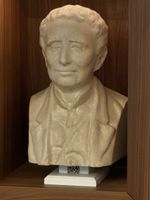 A French Hotel Celebrates Louis BrailleA new hotel in France celebrates innovators, including Louis Braille! His bust appears in the lobby among other great innovators. The Ki Space Hotel & Spa , located near Mr. Braille's hometown of Coupvray just outside Paris, also generously served as a sponsor for the Braille Bicentennial. How thrilling and uplifting to find a French...
A French Hotel Celebrates Louis BrailleA new hotel in France celebrates innovators, including Louis Braille! His bust appears in the lobby among other great innovators. The Ki Space Hotel & Spa , located near Mr. Braille's hometown of Coupvray just outside Paris, also generously served as a sponsor for the Braille Bicentennial. How thrilling and uplifting to find a French... -
![Video: Taste a rare French wine crafted by the blind community]() Taste a rare French wine crafted by the blind communityRaise a glass to Braille! The only blindness organization with its own winery in France, Voir Ensemble crafted this red Bordeaux for the Braille Bicentennial. Descriptive Transcript Beneath the canopy of an outdoor tent, Haben Girma gestures to the table beside her as she speaks with an American accent. Haben: For those of you who...
Taste a rare French wine crafted by the blind communityRaise a glass to Braille! The only blindness organization with its own winery in France, Voir Ensemble crafted this red Bordeaux for the Braille Bicentennial. Descriptive Transcript Beneath the canopy of an outdoor tent, Haben Girma gestures to the table beside her as she speaks with an American accent. Haben: For those of you who... -
![Video: Braille in France: So Many Meanings!]() Braille in France: So Many Meanings!In France, Braille may refer to the tactile reading system, the surname of its inventor, or the call of a strange and gorgeous bird! Thank you to artist and teacher Gabrielle Sauvillers and the Collège André Malraux in Amboise for expanding my understanding of Braille during my visit to France for the Braille Bicentennial. #BrailleFestival...
Braille in France: So Many Meanings!In France, Braille may refer to the tactile reading system, the surname of its inventor, or the call of a strange and gorgeous bird! Thank you to artist and teacher Gabrielle Sauvillers and the Collège André Malraux in Amboise for expanding my understanding of Braille during my visit to France for the Braille Bicentennial. #BrailleFestival... -
![Video: Blind Heroes & Breton Butter: Finding Braille in Saint-Malo]() Blind Heroes & Breton Butter: Finding Braille in Saint-MaloReading Braille out loud over the radio, a young blind woman assists the Allies in the Netflix series "All the Light We Cannot See." The show inspired me to visit Saint-Malo on my journey through France for the Braille Bicentennial. The tourist office offers large print and Braille brochures, videos with French Sign Language, wheelchairs...
Blind Heroes & Breton Butter: Finding Braille in Saint-MaloReading Braille out loud over the radio, a young blind woman assists the Allies in the Netflix series "All the Light We Cannot See." The show inspired me to visit Saint-Malo on my journey through France for the Braille Bicentennial. The tourist office offers large print and Braille brochures, videos with French Sign Language, wheelchairs... -
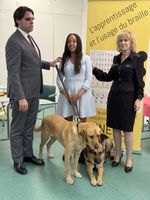 Visting Voir Ensemble in ParisA community of blind and sighted members, Voir Ensemble is an organization working to increase opportunities for blind people throughout France and francophone Africa. I had the honor of meeting with them in their Paris office, discussing disability rights in the U.S. and France. A core tenet here is l'autonomie, which roughly translates to self-determination....
Visting Voir Ensemble in ParisA community of blind and sighted members, Voir Ensemble is an organization working to increase opportunities for blind people throughout France and francophone Africa. I had the honor of meeting with them in their Paris office, discussing disability rights in the U.S. and France. A core tenet here is l'autonomie, which roughly translates to self-determination.... -
![Video: What is Dinner Table Syndrome?]() What is Dinner Table Syndrome?Having a seat at the table doesn't always mean being included. Deaf and Deafblind people often face dinner table syndrome --- missing out because communication barriers build walls. Watch Haben Girma and Rachel Kolb break it down and share solutions. How do YOU stay connected? Descriptive Transcript Haben Girma, a woman in her thirties with...
What is Dinner Table Syndrome?Having a seat at the table doesn't always mean being included. Deaf and Deafblind people often face dinner table syndrome --- missing out because communication barriers build walls. Watch Haben Girma and Rachel Kolb break it down and share solutions. How do YOU stay connected? Descriptive Transcript Haben Girma, a woman in her thirties with... -
![Video: Don't Miss the Braille Bicentennial in Coupvray, France!]() Don’t Miss Braille Bicentennial in Coupvray, France!Join us in celebrating 200 years of Braille at the Coupvray castle park on September 20, 2025. Visit Coupvray's website for more information about the Braille Bicentennial. Descriptive Transcript Haben Girma, a woman in her thirties with medium dark skin, long black hair, and dancing hazel eyes speaks to the camera. She has a mic...
Don’t Miss Braille Bicentennial in Coupvray, France!Join us in celebrating 200 years of Braille at the Coupvray castle park on September 20, 2025. Visit Coupvray's website for more information about the Braille Bicentennial. Descriptive Transcript Haben Girma, a woman in her thirties with medium dark skin, long black hair, and dancing hazel eyes speaks to the camera. She has a mic... -
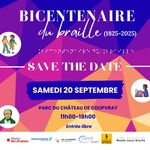 Haben is Honored to Speak at the Braille Bicentennial in Coupvray, FranceJoin us in celebrating 200 years of Braille! When Louis Braille became blind in 1812, schools lacked an effective way to teach reading and writing to blind students. After extensive experimentation, he developed the tactile reading system named after him. Today, countless blind people all over the world study textbooks, read recipes, and write computer...
Haben is Honored to Speak at the Braille Bicentennial in Coupvray, FranceJoin us in celebrating 200 years of Braille! When Louis Braille became blind in 1812, schools lacked an effective way to teach reading and writing to blind students. After extensive experimentation, he developed the tactile reading system named after him. Today, countless blind people all over the world study textbooks, read recipes, and write computer... -
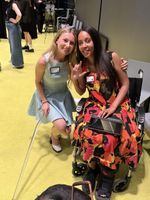 Making Space is a Resource for Job SeekersDo you know a disabled job seeker? Tell them about Making Space, an organization connecting disabled people with employers vetted for accessibility. Joining and taking their training courses is free for job seekers. Founders Keely Cat-Wells and Sophie Morgan , both disabled women tired of workplace discrimination, joined forces to smash systemic barriers. I finally...
Making Space is a Resource for Job SeekersDo you know a disabled job seeker? Tell them about Making Space, an organization connecting disabled people with employers vetted for accessibility. Joining and taking their training courses is free for job seekers. Founders Keely Cat-Wells and Sophie Morgan , both disabled women tired of workplace discrimination, joined forces to smash systemic barriers. I finally... -
![Video: I broke my ankle and now have 3 disabilities! My top 3 perks of using a wheelchair.]() I broke my ankle and now have 3 disabilities! My top 3 perks of using a wheelchair.I broke my ankle, and let me tell you: using a wheelchair while Deafblind is an experience for the next book! In honor of #DisabilityPrideMonth here are my favorite things about using a chair. Thank you to my friend Dr. H'Sien Hayward , a psychologist and experienced wheelchair user, for patiently answering all my chair...
I broke my ankle and now have 3 disabilities! My top 3 perks of using a wheelchair.I broke my ankle, and let me tell you: using a wheelchair while Deafblind is an experience for the next book! In honor of #DisabilityPrideMonth here are my favorite things about using a chair. Thank you to my friend Dr. H'Sien Hayward , a psychologist and experienced wheelchair user, for patiently answering all my chair... -
![Video: My first Braille Map Experience at a Garden: Seattle Sensory Garden]() My first Braille Map Experience at a Garden: Seattle Sensory GardenThe first time I experienced a Braille map of a garden was in Seattle. Thoughtfully designed exhibits throughout this oasis encourage us to savor all our senses; they even have a tribute to proprioception, the sense for knowing where your body is in space, a kind of internal GPS. While most gardens focus on sight,...
My first Braille Map Experience at a Garden: Seattle Sensory GardenThe first time I experienced a Braille map of a garden was in Seattle. Thoughtfully designed exhibits throughout this oasis encourage us to savor all our senses; they even have a tribute to proprioception, the sense for knowing where your body is in space, a kind of internal GPS. While most gardens focus on sight,... -
![Video: Touch Tour at the Museum of Flight in Seattle]() Touch Tour at the Museum of Flight in SeattleImagine a future where blind people building planes, flying planes, and shaping aviation policy is so common it ceases to be remarkable. Seattle's Museum of Flight has a selection of planes both blind and sighted people are encouraged to touch. Blind guests can also arrange an extended touch tour, and during my visit a pilot...
Touch Tour at the Museum of Flight in SeattleImagine a future where blind people building planes, flying planes, and shaping aviation policy is so common it ceases to be remarkable. Seattle's Museum of Flight has a selection of planes both blind and sighted people are encouraged to touch. Blind guests can also arrange an extended touch tour, and during my visit a pilot... -
![Video: One Deafblind, Unpaid Protestor]() Disabled People are Also ProtestingFor many disabled people, showing up at a protest requires planning. Will there be an ASL interpreter or will you need to find a volunteer? Will the space be wheelchair accessible? For me, as a Deafblind person, I need a seat or table for my Braille computer and keyboard. Organizers who share detailed accessibility information...
Disabled People are Also ProtestingFor many disabled people, showing up at a protest requires planning. Will there be an ASL interpreter or will you need to find a volunteer? Will the space be wheelchair accessible? For me, as a Deafblind person, I need a seat or table for my Braille computer and keyboard. Organizers who share detailed accessibility information... -
![Video: Love in the Lead: International Guide Dog Day]() Love in the Lead: International Guide Dog DayIt's International Guide Dog Day! Please share this video and encourage people to support The Seeing Eye . You can volunteer to help raise Seeing Eye puppies or make a donation by going to SeeingEye.org . Descriptive Transcript A German Shepherd dog on a big fluffy bed gazes toward the camera with his ears pointed....
Love in the Lead: International Guide Dog DayIt's International Guide Dog Day! Please share this video and encourage people to support The Seeing Eye . You can volunteer to help raise Seeing Eye puppies or make a donation by going to SeeingEye.org . Descriptive Transcript A German Shepherd dog on a big fluffy bed gazes toward the camera with his ears pointed.... -
![Video: Seeing Eye Dog Mylo Navigates Amsterdam]() Seeing Eye Dog Mylo Navigates AmsterdamAs cities embrace bicycles, let's not forget pedestrians. Thousands of bikes parked on sidewalks in Amsterdam force pedestrians into streets where they face even more bikes. Seeing Eye dog Mylo rose to the challenge, and I felt safer having him by my side. It's my hope city planners around the world design obstruction-free pedestrian pathways,...
Seeing Eye Dog Mylo Navigates AmsterdamAs cities embrace bicycles, let's not forget pedestrians. Thousands of bikes parked on sidewalks in Amsterdam force pedestrians into streets where they face even more bikes. Seeing Eye dog Mylo rose to the challenge, and I felt safer having him by my side. It's my hope city planners around the world design obstruction-free pedestrian pathways,... -
 Haben Will be Speaking at the University of HartfordI am excited to deliver a keynote at the University of Hartford on April 9th! The university has generously opened up this event to all, and captioning & ASL interpretation will be provided. Free registration: Spring 2025 Rogow Distinguished Visiting Lecturer -- University of Hartford
Haben Will be Speaking at the University of HartfordI am excited to deliver a keynote at the University of Hartford on April 9th! The university has generously opened up this event to all, and captioning & ASL interpretation will be provided. Free registration: Spring 2025 Rogow Distinguished Visiting Lecturer -- University of Hartford -
 Dosa Cones Pair Perfectly with Ice CreamDosa Cones Pair Perfectly with Ice Cream Dosa cones with heavenly ice cream keep me coming back to Koolfi Creamery. They have Indian-inspired flavors like mango lassi, as well as classics like cookies and cream. Their delicious dosa cones are vegan and gluten-free. You can find Koolfi Creamery in San Francisco and San Leandro, California....
Dosa Cones Pair Perfectly with Ice CreamDosa Cones Pair Perfectly with Ice Cream Dosa cones with heavenly ice cream keep me coming back to Koolfi Creamery. They have Indian-inspired flavors like mango lassi, as well as classics like cookies and cream. Their delicious dosa cones are vegan and gluten-free. You can find Koolfi Creamery in San Francisco and San Leandro, California.... -
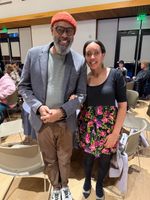 Advocating with Eric DozierEric Dozier is a cultural activist skillfully weaving stories and music to bring people together. He taught me the fascinating history behind Bob Marley's song, "War." Back in 1963 Emperor Haile Selassie spoke before the United Nations calling for the end of apartheid. Bob Marley adapted the speech into a song people still play today....
Advocating with Eric DozierEric Dozier is a cultural activist skillfully weaving stories and music to bring people together. He taught me the fascinating history behind Bob Marley's song, "War." Back in 1963 Emperor Haile Selassie spoke before the United Nations calling for the end of apartheid. Bob Marley adapted the speech into a song people still play today.... -
 When Mentors Become FriendsFighting discrimination from coast to coast, Deepa Goraya is a disability rights attorney. We met when she was a law student and I was in college wondering if I, too, could go to law school. Deepa generously answered my questions about law school as a blind student, sparking a wonderful friendship. She now lives in...
When Mentors Become FriendsFighting discrimination from coast to coast, Deepa Goraya is a disability rights attorney. We met when she was a law student and I was in college wondering if I, too, could go to law school. Deepa generously answered my questions about law school as a blind student, sparking a wonderful friendship. She now lives in... -
![Video: Haben, Daniela, and her husband José stand together on a sunny sidewalk. Haben wears a blue dress, Daniela wears a green shirt and jeans, and José wears a Navy blue shirt, khakis, and an Apple Watch. Next to German Shepherd Mylo is Rosie, a black lab, and beside José sits a yellow lab sweetly looking at the camera. Behind the smiling group, across the street, is a warm restaurant with indoor and outdoor seating.]() While Blind People use Tech, the Creativity is OursWhile Blind People use Tech, the Creativity is Ours Some sighted people assume screenreaders and other disability tech does all the work for blind people. Instead of saying "Carla wrote the report", her manager simply says "she used a screenreader", as if credit for the report rests with the screenreader. This kind of messaging impacts...
While Blind People use Tech, the Creativity is OursWhile Blind People use Tech, the Creativity is Ours Some sighted people assume screenreaders and other disability tech does all the work for blind people. Instead of saying "Carla wrote the report", her manager simply says "she used a screenreader", as if credit for the report rests with the screenreader. This kind of messaging impacts... -
![Video: Haben Girma and Mychal Threets: The Mental Health and Disability Connection]() Haben Girma and Mychal Threets: The Mental Health and Disability ConnectionThank you to the Berkeley Public Library for hosting this conversation between Haben Girma and Mychal Threets! This clip is an excerpt from the library's YouTube page. Video description Haben, Mychal, and an ASL interpreter sit in the front of a large room. Haben, a black woman in her 30s, wears a colorful flowing dress....
Haben Girma and Mychal Threets: The Mental Health and Disability ConnectionThank you to the Berkeley Public Library for hosting this conversation between Haben Girma and Mychal Threets! This clip is an excerpt from the library's YouTube page. Video description Haben, Mychal, and an ASL interpreter sit in the front of a large room. Haben, a black woman in her 30s, wears a colorful flowing dress.... -
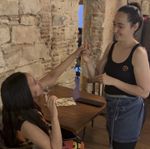 Eating at Ziryab, a Deaf-owned restaurant in BarcelonaEating at Ziryab, a Deaf-owned restaurant in Barcelona Disabled people bring innovative thinking to organizations, and disabled-owned businesses spark unforgettable experiences. Ziryab hires Deaf and hearing employees, and one of the owners is Deaf. It's an extremely popular restaurant in Barcelona. Why do you think that is? Descriptive Transcript Haben and her Seeing Eye dog...
Eating at Ziryab, a Deaf-owned restaurant in BarcelonaEating at Ziryab, a Deaf-owned restaurant in Barcelona Disabled people bring innovative thinking to organizations, and disabled-owned businesses spark unforgettable experiences. Ziryab hires Deaf and hearing employees, and one of the owners is Deaf. It's an extremely popular restaurant in Barcelona. Why do you think that is? Descriptive Transcript Haben and her Seeing Eye dog... -
![Video: Sensory Gardens: Ireland Versus Sweden]() Sensory Gardens: Ireland vs SwedenDreaming of a garden oasis? Allow me to share my experiences visiting the Garden for the Blind in Dublin, Ireland, and a sensory garden in Lund, Sweden. Each one teaches an accessibility feature communities can add to create beautiful, multisensory gardens. Descriptive Transcript Haben wears a short-sleeved navy blue dress, with her elbow resting on...
Sensory Gardens: Ireland vs SwedenDreaming of a garden oasis? Allow me to share my experiences visiting the Garden for the Blind in Dublin, Ireland, and a sensory garden in Lund, Sweden. Each one teaches an accessibility feature communities can add to create beautiful, multisensory gardens. Descriptive Transcript Haben wears a short-sleeved navy blue dress, with her elbow resting on... -
![Video: Teach Access Student Academy. Free 2 day virtual workshop on accessibility! Thursday, February 20th & Friday, February 21st. Whether you're new to accessibility or looking to deepen your understanding, this workshop will empower you to create a more accessible world! Students of all kinds are welcome. Sponsored by verizon, google, salesforce, meta, and Merck.]() Learn Accessibility Skills at the Teach Access Student AcademyLearn Accessibility Skills at the Teach Access Student Academy Increase your accessibility skills through the Teach Access Student Academy, a free virtual workshop on February 20 and 21. Register Descriptive Transcript Haben Girma, a Black woman in her thirties, stands in front of a blue wall. Haben: Do you want to learn more about accessibility?...
Learn Accessibility Skills at the Teach Access Student AcademyLearn Accessibility Skills at the Teach Access Student Academy Increase your accessibility skills through the Teach Access Student Academy, a free virtual workshop on February 20 and 21. Register Descriptive Transcript Haben Girma, a Black woman in her thirties, stands in front of a blue wall. Haben: Do you want to learn more about accessibility?... -
 Join Haben Girma & Mychal Threets at the Berkeley Public LibraryAuthor Haben Girma and librarian Mychal Threets invite you to the Berkeley Public Library, West Branch, for a conversation on disability stories, mental health, and accessibility. Join us in person or on Zoom. ASL interpretation, captioning, and the space is wheelchair accessible. Saturday January 11, 2:00 pm Pacific Berkeley Public Library Page with Zoom Link:...
Join Haben Girma & Mychal Threets at the Berkeley Public LibraryAuthor Haben Girma and librarian Mychal Threets invite you to the Berkeley Public Library, West Branch, for a conversation on disability stories, mental health, and accessibility. Join us in person or on Zoom. ASL interpretation, captioning, and the space is wheelchair accessible. Saturday January 11, 2:00 pm Pacific Berkeley Public Library Page with Zoom Link:... -
 World Braille Day 2025World Braille Day is January 4th, the birthday of blind inventor and teacher Louis Braille. Help us spread Braille accessibility around the globe! World Braille Day 2025 Watch this video on YouTube](https://youtu.be/VFFOSFMYysA) Two women sit in red chairs on the lower deck of a ferry. Haben Girma, a Black woman in her thirties, types on...
World Braille Day 2025World Braille Day is January 4th, the birthday of blind inventor and teacher Louis Braille. Help us spread Braille accessibility around the globe! World Braille Day 2025 Watch this video on YouTube](https://youtu.be/VFFOSFMYysA) Two women sit in red chairs on the lower deck of a ferry. Haben Girma, a Black woman in her thirties, types on... -
 Haben Will Speak at the Berkeley Public LibraryLiteracy ambassador Mychal Threets will chat with Haben Girma, author of Haben: The Deafblind Woman Who Conquered Harvard Law. Serving up captivating stories sprinkled with humor, their conversation will cover disability rights, mental health, and how to advocate for a barrier-free world. A Q&A will follow, and copies of Haben's book will be available for...
Haben Will Speak at the Berkeley Public LibraryLiteracy ambassador Mychal Threets will chat with Haben Girma, author of Haben: The Deafblind Woman Who Conquered Harvard Law. Serving up captivating stories sprinkled with humor, their conversation will cover disability rights, mental health, and how to advocate for a barrier-free world. A Q&A will follow, and copies of Haben's book will be available for... -
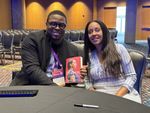 Yes, Disabled People Can Be DoctorsDr. O uses a wheelchair, and he's working toward a future where the idea of disabled people becoming doctors no longer surprises people. I had the honor of sharing the stage with him at the AAMC Annual Meeting, teaching medical schools about the need to increase accessibility for students. Dr. Oluwaferanmi O. Okanlami, MD, MS...
Yes, Disabled People Can Be DoctorsDr. O uses a wheelchair, and he's working toward a future where the idea of disabled people becoming doctors no longer surprises people. I had the honor of sharing the stage with him at the AAMC Annual Meeting, teaching medical schools about the need to increase accessibility for students. Dr. Oluwaferanmi O. Okanlami, MD, MS... -
![Video: Trying Vegan Donuts in Berlin]() Trying Vegan Donuts in BerlinVideo description I'm sitting at a picnic table with three colorful round pastries in front of me. Behind me is my German Shepherd Seeing Eye dog, and a cobblestone square lined with trees. Haben: This is going to be my first vegan donut experience. These are from Brammibal's, and they're actually the first fully vegan...
Trying Vegan Donuts in BerlinVideo description I'm sitting at a picnic table with three colorful round pastries in front of me. Behind me is my German Shepherd Seeing Eye dog, and a cobblestone square lined with trees. Haben: This is going to be my first vegan donut experience. These are from Brammibal's, and they're actually the first fully vegan... -
 Haben will be Speaking at Washington University’s Olin Business SchoolI'm thrilled to be speaking at Washington University's Olin Business School on Friday, December 6th. The hybrid event in Saint Louis, Missouri is open to the public, and ASL interpretation will be provided. Register at this link: Registration
Haben will be Speaking at Washington University’s Olin Business SchoolI'm thrilled to be speaking at Washington University's Olin Business School on Friday, December 6th. The hybrid event in Saint Louis, Missouri is open to the public, and ASL interpretation will be provided. Register at this link: Registration -
 Centering Disability Justice at the World Health SummitFor the first time, the World Health Summit held a high impact session centering health equity for disabled people. The enthusiasm of leaders from around the world underscored the need to address disability justice in all future health summits. I had the honor of moderating this historic session in Berlin on October 13, 2024. Key...
Centering Disability Justice at the World Health SummitFor the first time, the World Health Summit held a high impact session centering health equity for disabled people. The enthusiasm of leaders from around the world underscored the need to address disability justice in all future health summits. I had the honor of moderating this historic session in Berlin on October 13, 2024. Key... -
![Video: Take a Tactile Tour of the Healthy Materials Lab]() Take a Tactile Tour of the Healthy Materials LabBlind and sighted people can learn about cutting edge textiles at the Healthy Materials Lab. Taking a tactile tour introduced me to textures I'd read about but never felt, and others that completely surprised me. Located on the Parsons School of Design campus, part of The New School in New York City, the lab gives...
Take a Tactile Tour of the Healthy Materials LabBlind and sighted people can learn about cutting edge textiles at the Healthy Materials Lab. Taking a tactile tour introduced me to textures I'd read about but never felt, and others that completely surprised me. Located on the Parsons School of Design campus, part of The New School in New York City, the lab gives... -
![Video: Designing with Disability Pride: Professor Sugandha Gupta & Haben Girma at Parsons School of Fashion]() Designing with Disability Pride: Professor Sugandha Gupta & Haben Girma at Parsons School of FashionIf you've ever felt isolated and wondered how to build community, if you're frustrated with ableism and dream of designing in ways that no longer marginalize people, then you'll appreciate this video from the Parsons School of Fashion. Parsons' Disabled Fashion Student Program hosted this powerful conversation on October 16, 2024 at The New School...
Designing with Disability Pride: Professor Sugandha Gupta & Haben Girma at Parsons School of FashionIf you've ever felt isolated and wondered how to build community, if you're frustrated with ableism and dream of designing in ways that no longer marginalize people, then you'll appreciate this video from the Parsons School of Fashion. Parsons' Disabled Fashion Student Program hosted this powerful conversation on October 16, 2024 at The New School... -
 Apple’s Impressive AirPods Pro 2 Hearing Aids Launch a New Era of Health TechApple gave me early access to their groundbreaking AirPods Pro 2 hearing aids, and the chance to talk to Vice President of Health Dr. Sumbul Desai and Director of Global Accessibility Policy and Initiatives, Sarah Herrlinger. Designed for adults with mild to moderate hearing loss, these over-the-counter hearing aids provide an easy way to explore...
Apple’s Impressive AirPods Pro 2 Hearing Aids Launch a New Era of Health TechApple gave me early access to their groundbreaking AirPods Pro 2 hearing aids, and the chance to talk to Vice President of Health Dr. Sumbul Desai and Director of Global Accessibility Policy and Initiatives, Sarah Herrlinger. Designed for adults with mild to moderate hearing loss, these over-the-counter hearing aids provide an easy way to explore... -
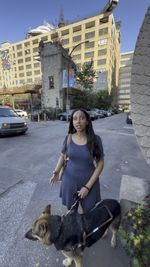 Uber Keeps Denying Service to Blind People with Guide Dogs – Join the Protest!Uber and Lyft frequently deny service to blind people with guide dogs. Help advocate for our civil rights by joining the National Federation of the Blind's Rideshare Rally in San Francisco on October 15, 10 am to 3 pm, outside the Uber and Lyft headquarters. More info . You can also share your experiences with...
Uber Keeps Denying Service to Blind People with Guide Dogs – Join the Protest!Uber and Lyft frequently deny service to blind people with guide dogs. Help advocate for our civil rights by joining the National Federation of the Blind's Rideshare Rally in San Francisco on October 15, 10 am to 3 pm, outside the Uber and Lyft headquarters. More info . You can also share your experiences with... -
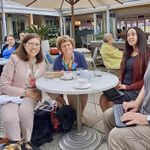 Haben’s Interview with Vision AustraliaBlind Australians campaigned for Vision Australia to open recruitment for their CEO position. Considering job applicants both inside and outside the agency would increase the opportunity for Vision Australia to hire their very first CEO who is blind. Hundreds of people signed the petition, and Vision Australia demonstrated true leadership by listening to blind people...
Haben’s Interview with Vision AustraliaBlind Australians campaigned for Vision Australia to open recruitment for their CEO position. Considering job applicants both inside and outside the agency would increase the opportunity for Vision Australia to hire their very first CEO who is blind. Hundreds of people signed the petition, and Vision Australia demonstrated true leadership by listening to blind people... -
 I Ate Bugs in Australia!Bug rolls are popular on the Gold Coast. Video description: Haben sits at a beachside restaurant, and on the table in front of her are two small sandwiches. They have a golden brioche bun, lettuce, sauce, and a fried patty. Haben: Australian food is fantastic! And the names for the items are really delightful. This...
I Ate Bugs in Australia!Bug rolls are popular on the Gold Coast. Video description: Haben sits at a beachside restaurant, and on the table in front of her are two small sandwiches. They have a golden brioche bun, lettuce, sauce, and a fried patty. Haben: Australian food is fantastic! And the names for the items are really delightful. This... -
 Haben Will Speak at the Parsons’ School of FashionJoin us at the Parsons' School of Fashion for a lively conversation on accessibility, disability justice, and joyful designs. Registration is free, and wheelchair access, captioning, and ASL interpretation will be provided. Excited to share the stage with Sugandha Gupta, an award-winning artist, Assistant Professor of Fashion Design and Social Justice, and a wonderful friend....
Haben Will Speak at the Parsons’ School of FashionJoin us at the Parsons' School of Fashion for a lively conversation on accessibility, disability justice, and joyful designs. Registration is free, and wheelchair access, captioning, and ASL interpretation will be provided. Excited to share the stage with Sugandha Gupta, an award-winning artist, Assistant Professor of Fashion Design and Social Justice, and a wonderful friend.... -
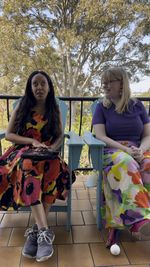 Hire Disabled Leaders, Especially at Disability OrganizationsWhen hiring for executive roles at disability organizations, isn't it better to select the most qualified leader regardless of whether they have a disability? Disability experience should be part of the qualification criteria for these jobs. These jobs involve representing the disabled community and speaking for the disability community. For example, the head of a...
Hire Disabled Leaders, Especially at Disability OrganizationsWhen hiring for executive roles at disability organizations, isn't it better to select the most qualified leader regardless of whether they have a disability? Disability experience should be part of the qualification criteria for these jobs. These jobs involve representing the disabled community and speaking for the disability community. For example, the head of a... -
 Trying Vegemite, The Famous Australian SpreadTrying Vegemite for the first time. A blend of vegetable extracts, B vitamins, and beer production leftovers, the spread packs a strong punch! Australians have eaten Vegemite for over a hundred years now. Descriptive Transcript Seated at an outdoor cafe, Haben has a plate with toast covered in a dark brown paste. Haben: When I...
Trying Vegemite, The Famous Australian SpreadTrying Vegemite for the first time. A blend of vegetable extracts, B vitamins, and beer production leftovers, the spread packs a strong punch! Australians have eaten Vegemite for over a hundred years now. Descriptive Transcript Seated at an outdoor cafe, Haben has a plate with toast covered in a dark brown paste. Haben: When I... -
![Video: Nessa and Haben sit on a stone pedestal, and behind them, with one monstrous paw on that same pedestal, is the scariest-looking koala. Black, white, and blue paint across his large body (possibly six feet tall) match the name the artists gave this sculpture: Darth Vader. His eyes glare with the face of an old, hooded person. The sculpture stands in the forest, and birds talk throughout the video. Haben's Seeing Eye dog stands by, a bit bored.]() Learning “Koala” in Australian Sign Language (Auslan)Happy International Week of the Deaf! It's technically next week, but let's celebrate every week! I'm learning Australian Sign Language (Auslan) from Vanessa Vlajkovic. We're both Deafblind and tactile signing. Learning "Koala" in Australian Sign Language (Auslan) Video description: Nessa and Haben sit on a stone pedestal, and behind them, with one monstrous paw on...
Learning “Koala” in Australian Sign Language (Auslan)Happy International Week of the Deaf! It's technically next week, but let's celebrate every week! I'm learning Australian Sign Language (Auslan) from Vanessa Vlajkovic. We're both Deafblind and tactile signing. Learning "Koala" in Australian Sign Language (Auslan) Video description: Nessa and Haben sit on a stone pedestal, and behind them, with one monstrous paw on... -
 Haben Speaking at the University of Cincinnati on September 25thIf you're in the Cincinnati area, join us for Digital Inclusion Day on September 25. You can register for my keynote at this link. Registration is free. Captioning & ASL interpretation will be provided. Register
Haben Speaking at the University of Cincinnati on September 25thIf you're in the Cincinnati area, join us for Digital Inclusion Day on September 25. You can register for my keynote at this link. Registration is free. Captioning & ASL interpretation will be provided. Register -
![Video: Haben and Seeing Eye dog Mylo stand next to a young woman. They're all smiling, and behind them is the Sydney Opera House, the bright blue water of the harbor, and the bridge.]() Sydney Opera House Tactile TourHow does a building look like sails, shells, and boats? The Sydney Opera House recently installed a tactile model for blind guests! Sydney Opera House Tactile Tour Descriptive Transcript Haben (Voiceover): The Sydney Opera House has a tactile model. She leans down to touch the bronze coated sculpture sitting on a low pedestal. The shape...
Sydney Opera House Tactile TourHow does a building look like sails, shells, and boats? The Sydney Opera House recently installed a tactile model for blind guests! Sydney Opera House Tactile Tour Descriptive Transcript Haben (Voiceover): The Sydney Opera House has a tactile model. She leans down to touch the bronze coated sculpture sitting on a low pedestal. The shape... -
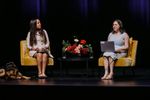 Haben Speaks at the University of New South WalesWill you try vegemite? ABC journalist Nas Campanella posed this question during our keynote at the University of New South Wales in Sydney. We discovered many similarities in the Australian and American disability experiences. Disability camps facilitate connection, allowing disabled people to share adaptive techniques and disability pride. But disability organizations need to do more...
Haben Speaks at the University of New South WalesWill you try vegemite? ABC journalist Nas Campanella posed this question during our keynote at the University of New South Wales in Sydney. We discovered many similarities in the Australian and American disability experiences. Disability camps facilitate connection, allowing disabled people to share adaptive techniques and disability pride. But disability organizations need to do more... -
 You have a Voice: Excerpt from the White House Disability Pride Month ConveningThey tried to silence her. They told her to limit her voice to disability issues, but Helen Keller never stopped advocating for human rights. You, too, have a voice. Keep advocating! This video is an excerpt from the White House Disability Pride Month Convening. The entire recording is on the White House YouTube channel. Descriptive...
You have a Voice: Excerpt from the White House Disability Pride Month ConveningThey tried to silence her. They told her to limit her voice to disability issues, but Helen Keller never stopped advocating for human rights. You, too, have a voice. Keep advocating! This video is an excerpt from the White House Disability Pride Month Convening. The entire recording is on the White House YouTube channel. Descriptive... -
 Haben Will be Speaking at the University of New South WalesI'm thrilled to be speaking in Sydney with Naz Campanella, an Australian Broadcasting Corporation journalist and the first blind newsreader to run a studio live to air. Join us for a lively conversation on disability advocacy, accessible travel, and the need for more disability stories. This talk is open to everyone and free. Please share...
Haben Will be Speaking at the University of New South WalesI'm thrilled to be speaking in Sydney with Naz Campanella, an Australian Broadcasting Corporation journalist and the first blind newsreader to run a studio live to air. Join us for a lively conversation on disability advocacy, accessible travel, and the need for more disability stories. This talk is open to everyone and free. Please share... -
 We All Need Accommodations: Excerpt From The White House Disability Pride Month Convening.The euphemism Special Needs, after many years of service, has filed for retirement. Nondisabled people receive countless supports, so why should supports for disabled people get treated as something extra? The only difference between accommodations for nondisabled and disabled people is ableism. That's why the overworked Special Needs decided the time had come to move...
We All Need Accommodations: Excerpt From The White House Disability Pride Month Convening.The euphemism Special Needs, after many years of service, has filed for retirement. Nondisabled people receive countless supports, so why should supports for disabled people get treated as something extra? The only difference between accommodations for nondisabled and disabled people is ableism. That's why the overworked Special Needs decided the time had come to move... -
 Libraries, Mental Health, & Accessibility with Mychal ThreetsHis brilliance, humor, and enchanting stories help people deepen their understanding of mental health. Mychal Threets @mychal3ts teaches how we can make libraries accessible for everyone, and sharing a stage with him at the White House was an absolute honor! Descriptive Transcript Mychal and Haben sit in chairs in an auditorium. Mychal types on a...
Libraries, Mental Health, & Accessibility with Mychal ThreetsHis brilliance, humor, and enchanting stories help people deepen their understanding of mental health. Mychal Threets @mychal3ts teaches how we can make libraries accessible for everyone, and sharing a stage with him at the White House was an absolute honor! Descriptive Transcript Mychal and Haben sit in chairs in an auditorium. Mychal types on a... -
 Slow-shaming is Ableist — Excerpt 1 from the White House Disability Pride Month ConveningFull video on the White House YouTube channel Descriptive Transcript Haben: Haben Girma speaking. Hello, everyone. So I am going to start with a visual description. It's an accessibility practice for our blind audience, and anyone who's multitasking. (Laughter) Haben: I'm a Black woman in my 30s. I'm wearing a blue dress. In front of...
Slow-shaming is Ableist — Excerpt 1 from the White House Disability Pride Month ConveningFull video on the White House YouTube channel Descriptive Transcript Haben: Haben Girma speaking. Hello, everyone. So I am going to start with a visual description. It's an accessibility practice for our blind audience, and anyone who's multitasking. (Laughter) Haben: I'm a Black woman in my 30s. I'm wearing a blue dress. In front of... -
 White House Disability Pride Month ConveningI'm excited to speak at the White House Disability Pride Month Convening on July 29th at 3:30 PM Eastern. We have a fantastic lineup of disability advocates speaking. You're all invited to tune in. In fact, July 29th is my birthday, so you're extra invited! The virtual event will have ASL interpretation and captioning. RSVP...
White House Disability Pride Month ConveningI'm excited to speak at the White House Disability Pride Month Convening on July 29th at 3:30 PM Eastern. We have a fantastic lineup of disability advocates speaking. You're all invited to tune in. In fact, July 29th is my birthday, so you're extra invited! The virtual event will have ASL interpretation and captioning. RSVP... -
![Video: Smelling & Tasting at the Disgusting Food Museum]() Smelling & Tasting at the Disgusting Food Museum in Malmö, SwedenMost museums have a visual culture, but this little museum takes guests on a multisensory tour. The Disgusting Food Museum also challenges our culinary biases. Descriptive Transcript Haben faces the camera holding a closed jar. Behind her is a wall of red and yellow cans. Haben: A lot of museums focus on visuals. I'm at...
Smelling & Tasting at the Disgusting Food Museum in Malmö, SwedenMost museums have a visual culture, but this little museum takes guests on a multisensory tour. The Disgusting Food Museum also challenges our culinary biases. Descriptive Transcript Haben faces the camera holding a closed jar. Behind her is a wall of red and yellow cans. Haben: A lot of museums focus on visuals. I'm at... -
 Another Way for Blind People to Cross Streets: Tactile Traffic MapsTactile maps increase independence and freedom for blind people, and this technology puts traffic maps at our fingertips. Should cities around the world install these accessible pedestrian signals? Descriptive Transcript I'm standing beside a yellow and navy plastic control box near a crosswalk. Haben: A Swedish style of accessible pedestrian signals can now be found...
Another Way for Blind People to Cross Streets: Tactile Traffic MapsTactile maps increase independence and freedom for blind people, and this technology puts traffic maps at our fingertips. Should cities around the world install these accessible pedestrian signals? Descriptive Transcript I'm standing beside a yellow and navy plastic control box near a crosswalk. Haben: A Swedish style of accessible pedestrian signals can now be found... -
 Deafblind Awareness Week: Everyone has a VoiceHelen Keller's birthday and Deafblind Awareness Week mark the perfect time to follow more Deafblind influencers. Here are some I follow, and if you know more tag them in the comments. Catarina Rivera @BlindishLatina Dr. Jasmine Simmons @ DrJasmineSimmons Loni Friedman @L.Friedmann Rebecca Alexander @RebeccaAlexander Molly Watt @MollyWattTalks Ashlea Brittney Hayes @AshleaBrittney Elsa Sjunneson @snarkbat...
Deafblind Awareness Week: Everyone has a VoiceHelen Keller's birthday and Deafblind Awareness Week mark the perfect time to follow more Deafblind influencers. Here are some I follow, and if you know more tag them in the comments. Catarina Rivera @BlindishLatina Dr. Jasmine Simmons @ DrJasmineSimmons Loni Friedman @L.Friedmann Rebecca Alexander @RebeccaAlexander Molly Watt @MollyWattTalks Ashlea Brittney Hayes @AshleaBrittney Elsa Sjunneson @snarkbat... -
 A Swedish Hotel Welcoming Blind & Sighted Guests: AlmåsaHotels embracing accessibility win more customers. The Almåsa Sea Hotel owned by Sweden's Visually Impaired Foundation has multi-sensory experiences enjoyed by both blind and sighted guests. Descriptive Transcript A paved path, with a railing, guides visitors through a fragrant garden. Seeing Eye dog Mylo and Haben stride along the path toward a dock over gently...
A Swedish Hotel Welcoming Blind & Sighted Guests: AlmåsaHotels embracing accessibility win more customers. The Almåsa Sea Hotel owned by Sweden's Visually Impaired Foundation has multi-sensory experiences enjoyed by both blind and sighted guests. Descriptive Transcript A paved path, with a railing, guides visitors through a fragrant garden. Seeing Eye dog Mylo and Haben stride along the path toward a dock over gently... -
 Haben Meets Paralympian & Adventurer Aron AndersonParalympian, speaker, author, and adventurer. Aron Anderson ( @AronAnderson1 ) is the first wheelchair user to reach the peak of Mount Kilimanjaro. And that is just the beginning! He leads groups on adventures around the world, showing people strategies to move through challenges. Descriptive Transcript Aron, Haben, and Seeing Eye dog Mylo are at a...
Haben Meets Paralympian & Adventurer Aron AndersonParalympian, speaker, author, and adventurer. Aron Anderson ( @AronAnderson1 ) is the first wheelchair user to reach the peak of Mount Kilimanjaro. And that is just the beginning! He leads groups on adventures around the world, showing people strategies to move through challenges. Descriptive Transcript Aron, Haben, and Seeing Eye dog Mylo are at a... -
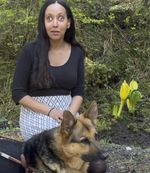 Site-smelling in Alaska: The Good and the GrossMany people talk about sight seeing, but that's only one small part of travel. Let's embrace all the different ways we can experience our world! Descriptive Transcript A wide, paved path curves around a fountain with a majestic whale statue, and then continues alongside the channel with beautiful views of Douglas Island and downtown Juneau....
Site-smelling in Alaska: The Good and the GrossMany people talk about sight seeing, but that's only one small part of travel. Let's embrace all the different ways we can experience our world! Descriptive Transcript A wide, paved path curves around a fountain with a majestic whale statue, and then continues alongside the channel with beautiful views of Douglas Island and downtown Juneau.... -
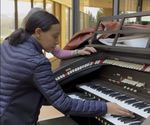 A Tactile Tour of Alaska’s Theatre OrganAs a Deafblind person in a complicated relationship with music, stepping inside this theater organ deepened my appreciation and understanding of this extraordinary instrument. Alaska's only working theater organ, older than the state, continues playing lovely music thanks to the Alaska State Museum, talented organists, and the passionate locals and tourists who attend the free...
A Tactile Tour of Alaska’s Theatre OrganAs a Deafblind person in a complicated relationship with music, stepping inside this theater organ deepened my appreciation and understanding of this extraordinary instrument. Alaska's only working theater organ, older than the state, continues playing lovely music thanks to the Alaska State Museum, talented organists, and the passionate locals and tourists who attend the free... -
 Add Descriptive Transcripts to Make Your Videos More AccessibleIt's Global Accessibility Awareness Day! Adding descriptive transcripts to videos helps Deafblind people and others who process information through text. Share this tip. Happy GAAD! Add Descriptive Transcripts to Make Your Videos More Accessible Descriptive Transcript Haben, a Black woman in her thirties with long dark hair, speaks to the camera, a vibrant blue wall...
Add Descriptive Transcripts to Make Your Videos More AccessibleIt's Global Accessibility Awareness Day! Adding descriptive transcripts to videos helps Deafblind people and others who process information through text. Share this tip. Happy GAAD! Add Descriptive Transcripts to Make Your Videos More Accessible Descriptive Transcript Haben, a Black woman in her thirties with long dark hair, speaks to the camera, a vibrant blue wall... -
 Alaskan Whale-watching Adventures while DeafblindWhale watching tours may seem purely visual, but thoughtful guides create interactive experiences that are fun even though I can't see the whales! Descriptive Transcript Experienced guide Laurie Clough approaches Haben holding a three-feet long, orange sea star. Haben gently studies the star with her fingers. Hundreds of tiny tube feet, yellow on the ends,...
Alaskan Whale-watching Adventures while DeafblindWhale watching tours may seem purely visual, but thoughtful guides create interactive experiences that are fun even though I can't see the whales! Descriptive Transcript Experienced guide Laurie Clough approaches Haben holding a three-feet long, orange sea star. Haben gently studies the star with her fingers. Hundreds of tiny tube feet, yellow on the ends,... -
 London vs Paris: Accessible Pedestrian SignalsLondon or Paris? Accessible pedestrian signals feel different across the channel, with their own pros and cons. Which style do you prefer and why? Descriptive Transcript Haben is standing at a crosswalk in London. She is wearing a lavender coat and long, gold earrings. She is speaking directly to the camera. Cars and red, double...
London vs Paris: Accessible Pedestrian SignalsLondon or Paris? Accessible pedestrian signals feel different across the channel, with their own pros and cons. Which style do you prefer and why? Descriptive Transcript Haben is standing at a crosswalk in London. She is wearing a lavender coat and long, gold earrings. She is speaking directly to the camera. Cars and red, double... -
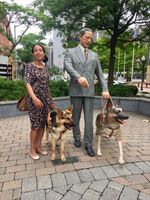 International Guide Dog DayHappy International Guide Dog Day! Gifts made to The Seeing Eye in honor of the day will be doubled! Seeing Eye Donation Page Haben and her Seeing Eye dog Mylo walk through a crowded airport. Haben is wearing a long lilac overcoat and a floral dress; she's wheeling a suitcase beside her. A man carrying...
International Guide Dog DayHappy International Guide Dog Day! Gifts made to The Seeing Eye in honor of the day will be doubled! Seeing Eye Donation Page Haben and her Seeing Eye dog Mylo walk through a crowded airport. Haben is wearing a long lilac overcoat and a floral dress; she's wheeling a suitcase beside her. A man carrying... -
 Disability Allyship: Milana Vayntrub & Haben GirmaDisability allyship has two crucial pillars: 1. Ask disabled people what we need, and 2. Based on those answers, take action to remove barriers. Actor, director, and comedian Milana Vayntrub role models disability allyship. AT&T invited Milana and I to share a stage, sparking a beautiful connection. We filmed this conversation after our electric keynote....
Disability Allyship: Milana Vayntrub & Haben GirmaDisability allyship has two crucial pillars: 1. Ask disabled people what we need, and 2. Based on those answers, take action to remove barriers. Actor, director, and comedian Milana Vayntrub role models disability allyship. AT&T invited Milana and I to share a stage, sparking a beautiful connection. We filmed this conversation after our electric keynote.... -
 How the Hand of Ableism Hijacks a Touch Tour for Blind Patrons at the British MuseumThe British Museum invites blind patrons to touch ancient sculptures, but when I placed my hands on one of these treasures an angry sighted person started harassing me. Video of the incident sparked outrage online. In March 2023 the BBC asked me to share what happened, and they aired a recording of me reading a...
How the Hand of Ableism Hijacks a Touch Tour for Blind Patrons at the British MuseumThe British Museum invites blind patrons to touch ancient sculptures, but when I placed my hands on one of these treasures an angry sighted person started harassing me. Video of the incident sparked outrage online. In March 2023 the BBC asked me to share what happened, and they aired a recording of me reading a... -
 Nikil’s Treasures: The Braille & Large Print Books at India’s Accessible Reading Materials LibraryUgly and too expensive, scoffed critics. But the astounding beauty and creativity in these books speaks volumes! Dr. Namita Jacob felt frustrated by the scarcity of accessible books in India. She founded the Accessible Reading Materials Library, Chetana Charitable Trust, a community of volunteers making Braille, large print, joy-filled books that allow blind kids and...
Nikil’s Treasures: The Braille & Large Print Books at India’s Accessible Reading Materials LibraryUgly and too expensive, scoffed critics. But the astounding beauty and creativity in these books speaks volumes! Dr. Namita Jacob felt frustrated by the scarcity of accessible books in India. She founded the Accessible Reading Materials Library, Chetana Charitable Trust, a community of volunteers making Braille, large print, joy-filled books that allow blind kids and... -
![Video: Haben feeling a black robotic hand that is signing the letter "S"]() A New Tool for Deafblind People: A Signing Robot HandIf you can't read Braille, what do you think of reading a robot hand? A New Tool for Deafblind People: A Signing Robot Hand Video Description A black-gloved, human-sized hand sticks up from a base with about a dozen buttons. As it signs the American Sign Language letters S-U-N it makes a mechanical whirring sound....
A New Tool for Deafblind People: A Signing Robot HandIf you can't read Braille, what do you think of reading a robot hand? A New Tool for Deafblind People: A Signing Robot Hand Video Description A black-gloved, human-sized hand sticks up from a base with about a dozen buttons. As it signs the American Sign Language letters S-U-N it makes a mechanical whirring sound.... -
 Seeing Eye Dog Mylo and Haben Visiting Juneau, AlaskaOn Wednesday May 1, 2024 the Juneau Public Library is hosting a reading and discussion with Haben Girma. She will read, in Braille, from her book Haben: The Deafblind Woman Who Conquered Harvard Law. She welcomes questions, and Mylo does, too! Join us for an engaging conversation on how we all can make our communities...
Seeing Eye Dog Mylo and Haben Visiting Juneau, AlaskaOn Wednesday May 1, 2024 the Juneau Public Library is hosting a reading and discussion with Haben Girma. She will read, in Braille, from her book Haben: The Deafblind Woman Who Conquered Harvard Law. She welcomes questions, and Mylo does, too! Join us for an engaging conversation on how we all can make our communities... -
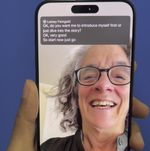 An iPhone Feature Helping Deaf/Hard of Hearing People: Live CaptionsMy friend Lainey Feingold showed her 91-year-old dad how to turn on Live Captions on his iPhone, and now he loves how much easier phone calls are for him. How many other elders don't know about Live Captions? Everyone, including our elders, should have communication tools that help facilitate connection. Share accessibility features with elders...
An iPhone Feature Helping Deaf/Hard of Hearing People: Live CaptionsMy friend Lainey Feingold showed her 91-year-old dad how to turn on Live Captions on his iPhone, and now he loves how much easier phone calls are for him. How many other elders don't know about Live Captions? Everyone, including our elders, should have communication tools that help facilitate connection. Share accessibility features with elders... -
![Video: Haben feeds paper into her Juliet Pro Embosser]() Sweet Juliet, Free of Planned ObsolesceA Blind Woman Brailling Like It's 1995 This Juliet embosser helped me through college and law school. She followed me from Portland to Boston to Oakland, and dents along her surface commemorate each trip. Newer, lighter, flashier Braille printers exist, but this still works for me. Descriptive Transcript I'm feeding paper into a large machine,...
Sweet Juliet, Free of Planned ObsolesceA Blind Woman Brailling Like It's 1995 This Juliet embosser helped me through college and law school. She followed me from Portland to Boston to Oakland, and dents along her surface commemorate each trip. Newer, lighter, flashier Braille printers exist, but this still works for me. Descriptive Transcript I'm feeding paper into a large machine,... -
![Video: A Bias Challenge at the Exploratorium]() A Bias Challenge at the ExploratoriumA Bias Challenge at the Exploratorium Can you get past assumptions of what a drinking fountain should look like? The Exploratorium , a science museum in San Francisco, has a sign saying both fountains are safe. Which one would you sip from? Most people pick the traditional fountain. The exhibit invites people to notice that...
A Bias Challenge at the ExploratoriumA Bias Challenge at the Exploratorium Can you get past assumptions of what a drinking fountain should look like? The Exploratorium , a science museum in San Francisco, has a sign saying both fountains are safe. Which one would you sip from? Most people pick the traditional fountain. The exhibit invites people to notice that... -
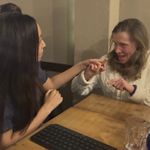 Learning Italian Sign Language at a Deaf-owned wine bar in ItalyDo you learn new sign languages when you travel? One of my favorite memories from Italy: getting to know Barbara Voyageuse Verna, a Deafblind woman who is working to establish a Deafblind association. We met up at the Deaf-owned Ânma winebar in Reggio Emilia. The warm space, with its scrumptious snacks and drinks, welcomes people...
Learning Italian Sign Language at a Deaf-owned wine bar in ItalyDo you learn new sign languages when you travel? One of my favorite memories from Italy: getting to know Barbara Voyageuse Verna, a Deafblind woman who is working to establish a Deafblind association. We met up at the Deaf-owned Ânma winebar in Reggio Emilia. The warm space, with its scrumptious snacks and drinks, welcomes people... -
 Visiting Albany Law SchoolVisiting Albany Law School introduced me to many enthusiastic advocates, some who are new to accessibility and some who have been championing disability justice for years! Thank you, Albany, for inviting me to deliver the 2024 author lecture!
Visiting Albany Law SchoolVisiting Albany Law School introduced me to many enthusiastic advocates, some who are new to accessibility and some who have been championing disability justice for years! Thank you, Albany, for inviting me to deliver the 2024 author lecture! -
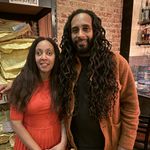 Reading, in Braille, from Haben: the Deafblind Woman who Conquered Harvard LawTranscript The reading is an excerpt from Haben: The Deafblind Woman Who Conquered Harvard Law by Haben Girma with a Forward by Stephen Curry. Video Description : Pam Johnson stands beside me, signing in American Sign Language as I speak. I'm sitting at a table reading from a short stack of Braille pages, and my...
Reading, in Braille, from Haben: the Deafblind Woman who Conquered Harvard LawTranscript The reading is an excerpt from Haben: The Deafblind Woman Who Conquered Harvard Law by Haben Girma with a Forward by Stephen Curry. Video Description : Pam Johnson stands beside me, signing in American Sign Language as I speak. I'm sitting at a table reading from a short stack of Braille pages, and my... -
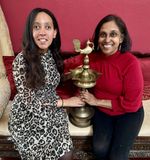 Angels of ImpactHow do we create a future where poverty exists only in museum exhibits? Before she became CEO of Angels of Impact , Laina Raveendran Greene studied this question in and outside the classroom. She volunteered and donated to charities, but surely there was more we could do? Laina authored the guidebook Sustainable Impact: How Women...
Angels of ImpactHow do we create a future where poverty exists only in museum exhibits? Before she became CEO of Angels of Impact , Laina Raveendran Greene studied this question in and outside the classroom. She volunteered and donated to charities, but surely there was more we could do? Laina authored the guidebook Sustainable Impact: How Women... -
 World Braille Day 2024It's World Braille Day! A blind teacher named Louis Braille created this tactile reading system, and now his birthday, January 4, is a day to celebrate this marvelous way to read! Braille exists in multiple languages, and I recently had the honor of meeting Sabriye Tenberken, also blind, who invented and taught Tibetan Braille. In...
World Braille Day 2024It's World Braille Day! A blind teacher named Louis Braille created this tactile reading system, and now his birthday, January 4, is a day to celebrate this marvelous way to read! Braille exists in multiple languages, and I recently had the honor of meeting Sabriye Tenberken, also blind, who invented and taught Tibetan Braille. In... -
 Visiting Kanthari, a social impact institute in IndiaInspiration should lead to action. A blind woman who invented Tibetan Braille and overcame political red tape and ableism, Sabriye Tenberken both role models and teaches social impact. Want to start an NGO? Need help finding donors? Want advise navigating oppressive bureaucracy? Take the course at Kanthari, this social impact institute I was very lucky...
Visiting Kanthari, a social impact institute in IndiaInspiration should lead to action. A blind woman who invented Tibetan Braille and overcame political red tape and ableism, Sabriye Tenberken both role models and teaches social impact. Want to start an NGO? Need help finding donors? Want advise navigating oppressive bureaucracy? Take the course at Kanthari, this social impact institute I was very lucky... -
 Haben Appointed Commissioner of the WHO Commission on Social ConnectionI have exciting news to share: the World Health Organization (WHO) has appointed me Commissioner of the new Commission on Social Connection! The WHO established this new Commission because loneliness and social isolation impact public health around the globe. As someone who struggled with isolation, as a Deafblind woman in a sighted, hearing world, as...
Haben Appointed Commissioner of the WHO Commission on Social ConnectionI have exciting news to share: the World Health Organization (WHO) has appointed me Commissioner of the new Commission on Social Connection! The WHO established this new Commission because loneliness and social isolation impact public health around the globe. As someone who struggled with isolation, as a Deafblind woman in a sighted, hearing world, as... -
Disability SimulationsShould event planners ask attendees to close their eyes, walk around the hotel for an hour, and imagine what it's like being blind? No, and this article explains why disability simulation exercises are problematic. Article: Accessibility Advocates Oppose Disability Simulations
-
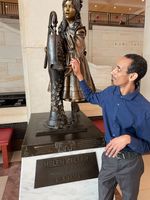 National Deafblind Equipment Distribution Program Troubles in CaliforniaMany deafblind people rely on the FCC's National Deafblind Equipment Distribution Program for braille tech & training, which can cost thousands of dollars. But Californians are struggling to access the program. Dear FCC, please find a new partner organization in CA. Read the report: When there is no accountability, accessibility suffers.
National Deafblind Equipment Distribution Program Troubles in CaliforniaMany deafblind people rely on the FCC's National Deafblind Equipment Distribution Program for braille tech & training, which can cost thousands of dollars. But Californians are struggling to access the program. Dear FCC, please find a new partner organization in CA. Read the report: When there is no accountability, accessibility suffers. -
World Health Organization Technical Advisory Group on Social ConnectionThe World Health Organization is creating a Technical Advisory Group on Social Connection to study what causes social isolation and how to create healtheir, more connected communities. If you know someone with ideas for the WHO, please encourage them to apply. Article: Call for Experts -- Technical Advisory Group on Social Connection
-
![Video: Learning Mexican Sign Language]() Learning Mexican Sign LanguageAmerican Sign Language (ASL) is different from Mexican Sign Language (LSM). A patient & gifted Deaf LSM instructor, Yahir Alejandro taught me these signs. Will you, too, learn LSM or your local sign language? For more from Yahir, follow him on Instagram @YahirAlejandroRM . Video description: Yahir is a young, sighted, Deaf man, and Haben...
Learning Mexican Sign LanguageAmerican Sign Language (ASL) is different from Mexican Sign Language (LSM). A patient & gifted Deaf LSM instructor, Yahir Alejandro taught me these signs. Will you, too, learn LSM or your local sign language? For more from Yahir, follow him on Instagram @YahirAlejandroRM . Video description: Yahir is a young, sighted, Deaf man, and Haben... -
 Binational Forum of Deaf CultureServing as the keynote speaker for the first Binational Forum of Deaf Culture, I met many passionate advocates working to increase accessibility in Mexico. Some things I learned: The state of Sonora officially recognized Mexican Sign Language (LSM) as a language in 2022, thanks to the Deaf community's awareness campaign. There is an extreme shortage...
Binational Forum of Deaf CultureServing as the keynote speaker for the first Binational Forum of Deaf Culture, I met many passionate advocates working to increase accessibility in Mexico. Some things I learned: The state of Sonora officially recognized Mexican Sign Language (LSM) as a language in 2022, thanks to the Deaf community's awareness campaign. There is an extreme shortage... -
 IndeedSociety tells disabled job seekers, "Just work harder." But many already exceed the efforts of non disabled people. It's employers who must work harder to fight ableism. Grateful to be able to share this message with HR professionals during my keynote at Indeed FutureWorks!
IndeedSociety tells disabled job seekers, "Just work harder." But many already exceed the efforts of non disabled people. It's employers who must work harder to fight ableism. Grateful to be able to share this message with HR professionals during my keynote at Indeed FutureWorks! -
 Haben at GartnerAfter my keynote at Gartner's conference an attendee told me they're inspired to make their websites and apps more accessible to disabled people. My favorite kind of inspiration!
Haben at GartnerAfter my keynote at Gartner's conference an attendee told me they're inspired to make their websites and apps more accessible to disabled people. My favorite kind of inspiration! -
San Francisco Lighthouse UnionBlind workers at the San Francisco Lighthouse are organizing a union, the first blind-centered union in California! So exciting! Hoping the LightHouse for the Blind and Visually Impaired's management decides to recognize the new union Article: Blind, visually impaired workers at LightHouse kick off union --- first of its kind in Bay Area
-
 Ponta da Ilha LighthouseThe lighthouse had their first blind visitor, and they turned it into an opportunity to search high and low for all the tactile experiences! They showed me the reserve light, the antique light, and they invited my guide dog and I to climb the stairs as high as we were comfortable going. The long, spiraling...
Ponta da Ilha LighthouseThe lighthouse had their first blind visitor, and they turned it into an opportunity to search high and low for all the tactile experiences! They showed me the reserve light, the antique light, and they invited my guide dog and I to climb the stairs as high as we were comfortable going. The long, spiraling... -
 Ocean BreezeShe loves her island, but doctors said if she wants to learn braille she has to leave her home for mainland Portugal. This is ableism. Institutions around the world have traditionally removed disabled people from their homes and placed them in special schools and centers. While many of these centers provide great learning opportunities, we...
Ocean BreezeShe loves her island, but doctors said if she wants to learn braille she has to leave her home for mainland Portugal. This is ableism. Institutions around the world have traditionally removed disabled people from their homes and placed them in special schools and centers. While many of these centers provide great learning opportunities, we... -
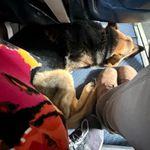 He Fits! Mylo on Azores AirlinesHe fits! Azores Airlines claims the only way a service dog can fit is by having a disabled person sit alone next to an empty seat. Instead of making assumptions based on a dog's weight, airlines should ask us how we'd like to fly with our dogs. Many disabled people have strategies for traveling with...
He Fits! Mylo on Azores AirlinesHe fits! Azores Airlines claims the only way a service dog can fit is by having a disabled person sit alone next to an empty seat. Instead of making assumptions based on a dog's weight, airlines should ask us how we'd like to fly with our dogs. Many disabled people have strategies for traveling with... -
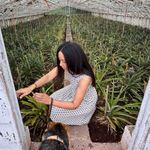 Augusto Arruda Pineapple PlantationConfession: I thought pineapples grew on trees. Reason 98973 to increase accessibility at public gardens. Thanks to the Augusto Arruda Pineapple Plantation for welcoming my guide dog!
Augusto Arruda Pineapple PlantationConfession: I thought pineapples grew on trees. Reason 98973 to increase accessibility at public gardens. Thanks to the Augusto Arruda Pineapple Plantation for welcoming my guide dog! -
 Mylo at the Azorean BeachSeeing Eye dog Mylo is with me in the Azores! Thank you to everyone who shared my video describing Azores Airlines' policy of separating disabled travelers from family/friends! The U.S. Department of Transportation confirmed they are investigating Azores Airlines. We flew here with United Airlines, which generously upgraded us to bulkhead seats that gave Mylo...
Mylo at the Azorean BeachSeeing Eye dog Mylo is with me in the Azores! Thank you to everyone who shared my video describing Azores Airlines' policy of separating disabled travelers from family/friends! The U.S. Department of Transportation confirmed they are investigating Azores Airlines. We flew here with United Airlines, which generously upgraded us to bulkhead seats that gave Mylo... -
![Video: This airline separates disabled travelers from family/friends]() This airline separates disabled travelers from family/friendsTranscript (Haben speaking): Because I'm blind, an airline is saying I have to sit alone. We booked side-by-side seats. But when they found out I'm blind, they separated us. They're claiming it's their policy that if a person has a service dog over 55 pounds, they need a separate extra seat because they assume the...
This airline separates disabled travelers from family/friendsTranscript (Haben speaking): Because I'm blind, an airline is saying I have to sit alone. We booked side-by-side seats. But when they found out I'm blind, they separated us. They're claiming it's their policy that if a person has a service dog over 55 pounds, they need a separate extra seat because they assume the... -
 “Disability Sparks Innovation” | Haben Profiled on Forbes'Disability Sparks Innovation': Insights From Deafblind Human Rights Lawyer Haben Girma
“Disability Sparks Innovation” | Haben Profiled on Forbes'Disability Sparks Innovation': Insights From Deafblind Human Rights Lawyer Haben Girma -
 It’s My Birthday!It's my birthday! Reading is one of my favorite things, especially humor-filled stories, so pleas send me your book recommendations! Highlights from this past year: Year of the Tiger by Alice Wong True Biz by Sara Novic Joan is Okay by Weike Wang The Thursday Murder Club by Richard Osman Sipping Dom Perignon through a...
It’s My Birthday!It's my birthday! Reading is one of my favorite things, especially humor-filled stories, so pleas send me your book recommendations! Highlights from this past year: Year of the Tiger by Alice Wong True Biz by Sara Novic Joan is Okay by Weike Wang The Thursday Murder Club by Richard Osman Sipping Dom Perignon through a... -
Disability Pride MonthJuly is Disability Pride Month, an invitation to reflect on accessibility in our communities. What are you inspired to do, what action will you take, to make your organization more inclusive? Article: 'Disability Sparks Innovation': Insights From Deafblind Human Rights Lawyer Haben Girma
-
 On Parks, Guide Dogs, & AbleismPark rangers stop us every time. "No dogs allowed. You need to leave." Their surprise upon learning it's a real, actual Seeing Eye dog puzzles me. The Parks & Recreation Department trains them to identify coyotes and mountain lions, but not Seeing Eye dogs? But today was different. The ground shook as their truck drove...
On Parks, Guide Dogs, & AbleismPark rangers stop us every time. "No dogs allowed. You need to leave." Their surprise upon learning it's a real, actual Seeing Eye dog puzzles me. The Parks & Recreation Department trains them to identify coyotes and mountain lions, but not Seeing Eye dogs? But today was different. The ground shook as their truck drove... -
 Speaking at DeloitteI delivered a keynote at Deloitte University , and imagine my delight in discovering this tactile, Deafblind-accessible sign! The design allows people to see or feel equity.
Speaking at DeloitteI delivered a keynote at Deloitte University , and imagine my delight in discovering this tactile, Deafblind-accessible sign! The design allows people to see or feel equity. -
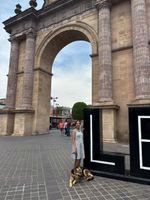 A Guide Dog in MexicoTraveling to Mexico with a guide dog has gotten so much easier! A USDA endorsed health certificate is no longer required, cutting down on extra vet visits, costs, and stress. All we need is proof of rabies vaccination and the usual U.S. DOT Service Animal Air Transportation form. When we arrived in Mexico, a customs...
A Guide Dog in MexicoTraveling to Mexico with a guide dog has gotten so much easier! A USDA endorsed health certificate is no longer required, cutting down on extra vet visits, costs, and stress. All we need is proof of rabies vaccination and the usual U.S. DOT Service Animal Air Transportation form. When we arrived in Mexico, a customs... -
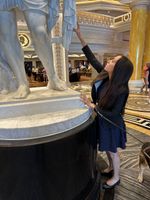 Teaching Accessibility at Caesar’s PalaceStanding on the Caesars Palace stage, I invited tech leaders to think of disability-inclusive designs as opportunities for greater innovation. An audience is a gift, and I'm grateful Gartner gave me this platform to teach people about accessibility.
Teaching Accessibility at Caesar’s PalaceStanding on the Caesars Palace stage, I invited tech leaders to think of disability-inclusive designs as opportunities for greater innovation. An audience is a gift, and I'm grateful Gartner gave me this platform to teach people about accessibility. -
![Video: A New Accessible Pedestrian Signal for Blind Travelers]() A New Accessible Pedestrian Signal for Blind TravelersMost street corners lack pedestrian signals we can feel or hear. Imagine the liberation offered by an app using AI to read visual signals! OKO is free, too! I'm excited for portable, accessible pedestrian signals, but I also have questions: How reliable is it? Video Description Haben Girma and her guide dog Mylo are standing...
A New Accessible Pedestrian Signal for Blind TravelersMost street corners lack pedestrian signals we can feel or hear. Imagine the liberation offered by an app using AI to read visual signals! OKO is free, too! I'm excited for portable, accessible pedestrian signals, but I also have questions: How reliable is it? Video Description Haben Girma and her guide dog Mylo are standing... -
![Video: Sign the Petition Opposing California's Ableist End of Life Option Act]() Sign the Petition Opposing California’s Ableist End of Life Option ActOver eighty percent of physicians suffer from disability bias, yet California's End of Life Option Act lacks protections against ableism and racism. We have filed a lawsuit to stop this discriminatory law. Please add your name to the petition Read about the case If you or someone you know needs immediate help, call or text...
Sign the Petition Opposing California’s Ableist End of Life Option ActOver eighty percent of physicians suffer from disability bias, yet California's End of Life Option Act lacks protections against ableism and racism. We have filed a lawsuit to stop this discriminatory law. Please add your name to the petition Read about the case If you or someone you know needs immediate help, call or text... -
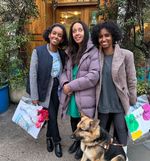 Deaf Twins Hermon and Heroda Berhane Advocate for Greater Accessibility on TinderIn the UK, 71% of Tinder users would feel nervous dating a deaf person. Relax! Deaf twins Hermon & Heroda (a.k.a. Being Her) teamed up with Tinder to teach British Sign Language and share accessible dating tips. Here are three. Do you have tips to add? 1. Ask the person how they would like to...
Deaf Twins Hermon and Heroda Berhane Advocate for Greater Accessibility on TinderIn the UK, 71% of Tinder users would feel nervous dating a deaf person. Relax! Deaf twins Hermon & Heroda (a.k.a. Being Her) teamed up with Tinder to teach British Sign Language and share accessible dating tips. Here are three. Do you have tips to add? 1. Ask the person how they would like to... -
 Tilting The LensDisabled educator & author, Sinéad Burke founded Tilting The Lens to increase accessibility in fashion. The industry has already mainstreamed glasses, and one day all our disability accessories, from canes to clothing that flatters unique bodies, will be equally accepted. Thank you, Sinead and Emma!
Tilting The LensDisabled educator & author, Sinéad Burke founded Tilting The Lens to increase accessibility in fashion. The industry has already mainstreamed glasses, and one day all our disability accessories, from canes to clothing that flatters unique bodies, will be equally accepted. Thank you, Sinead and Emma! -
 World Health Day 2023It's World Health Day! I met with World Health Organization Director-General Dr. Tedros to help launch the Global Report on Health Equity for Persons with Disabilities. Share it with your local health agencies & schools. Tell them to remove barriers facing disabled people.
World Health Day 2023It's World Health Day! I met with World Health Organization Director-General Dr. Tedros to help launch the Global Report on Health Equity for Persons with Disabilities. Share it with your local health agencies & schools. Tell them to remove barriers facing disabled people. -
 Guide Dogs and Green Vests in LondonIn London we've received a lot of, "If he's a real guide dog why isn't he wearing green?" First of all, blind people can & do style up their dogs. Second, guide dog schools exist all over the world with many variations. It's the training that makes a guide dog, not the outfit. Believe blind...
Guide Dogs and Green Vests in LondonIn London we've received a lot of, "If he's a real guide dog why isn't he wearing green?" First of all, blind people can & do style up their dogs. Second, guide dog schools exist all over the world with many variations. It's the training that makes a guide dog, not the outfit. Believe blind... -
 Visiting the Anne Frank HouseAt the Anne Frank House, a wonderful guide led us on a touch tour: a sculpture of Anne writing with a fountain pen, the original bookcase that concealed the secret annex, steep ankle-twisting stairs that were challenging for my guide dog Mylo (he managed with assistance), empty rooms carrying the immense loss of the Frank...
Visiting the Anne Frank HouseAt the Anne Frank House, a wonderful guide led us on a touch tour: a sculpture of Anne writing with a fountain pen, the original bookcase that concealed the secret annex, steep ankle-twisting stairs that were challenging for my guide dog Mylo (he managed with assistance), empty rooms carrying the immense loss of the Frank... -
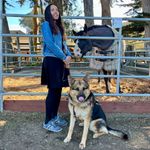 Mylo meets Milo the HorseMilo, a lovely horse, meets Mylo, my Seeing Eye dog. To their surprise and delight, they both have humans who went to Harvard Law!
Mylo meets Milo the HorseMilo, a lovely horse, meets Mylo, my Seeing Eye dog. To their surprise and delight, they both have humans who went to Harvard Law! -
 Ableism at the British MuseumOnly blind people can touch ancient treasures at the British Museum, but this jealous sightie can't handle it. The museum has an astounding number of ancient sculptures not covered in glass or even roped off. Signs next to them prohibit touching, but that ban is for the sighted. On the same sign is a symbol...
Ableism at the British MuseumOnly blind people can touch ancient treasures at the British Museum, but this jealous sightie can't handle it. The museum has an astounding number of ancient sculptures not covered in glass or even roped off. Signs next to them prohibit touching, but that ban is for the sighted. On the same sign is a symbol... -
 Delivering a Marriage Application in AtlantaI delivered a marriage application for a dear friend. Serving as an officiant, celebrating two people's love for each other, is one of the most beautiful experiences. Feeling incredibly grateful. Happy to share that everyone at the courthouse was welcoming, too. The clerk said, "Congratulations!" My role, officiant not bride, was quickly clarified, but that...
Delivering a Marriage Application in AtlantaI delivered a marriage application for a dear friend. Serving as an officiant, celebrating two people's love for each other, is one of the most beautiful experiences. Feeling incredibly grateful. Happy to share that everyone at the courthouse was welcoming, too. The clerk said, "Congratulations!" My role, officiant not bride, was quickly clarified, but that... -
 World Braille DayHappy World Braille Day! Louis Braille, a blind teacher, dreamed of a way for his students to enjoy books on their own. How would one read or write without sight? He invented a tactile reading system used by millions of blind people, and his birthday is now a day to celebrate this marvelous way to...
World Braille DayHappy World Braille Day! Louis Braille, a blind teacher, dreamed of a way for his students to enjoy books on their own. How would one read or write without sight? He invented a tactile reading system used by millions of blind people, and his birthday is now a day to celebrate this marvelous way to... -
Exploring world monuments through Spain’s Museum for the BlindThis amazing museum has gorgeous tactile models of world monuments and Spanish treasures. Museums like this are still so rare. I wish more organizations provided blind people with access to tactile models like this!
-
 Delivering a Lecture at the Lighthouse GuildI was honored to deliver Lighthouse Guild's very first Dr. Alan R. Morse Lecture in Advocacy! They supported my college education through a scholarship, and back then I never imagined that I would one day become a disability justice leader. Thank you, Lighthouse Guild! Let's keep lifting up disabled advocates! Do you know a blind...
Delivering a Lecture at the Lighthouse GuildI was honored to deliver Lighthouse Guild's very first Dr. Alan R. Morse Lecture in Advocacy! They supported my college education through a scholarship, and back then I never imagined that I would one day become a disability justice leader. Thank you, Lighthouse Guild! Let's keep lifting up disabled advocates! Do you know a blind... -
Cool Tactile Guiding Paths for Blind PeopleTactile paths for blind people are popping up all over the world! I loved feeling them under my feet. Strangely, some paths abruptly end for no reason. Tactile paths can't replace canes and guide dogs, but many communities don't have blind travel instructors. Lara Guide Dog School provides orientation & mobility training to blind people...
-
![Video: Zap Ableism from Space Exploration]() Zap Ableism from Space ExplorationBecause of limited support for this great organization, because of systemic ableism, the disabled researchers will not be paid. Society needs to invest in STEM accessibility and treat disabled researchers as equals. Transcript They're asking disabled people to put our bodies on the line for research. A team of disabled researchers will go on a...
Zap Ableism from Space ExplorationBecause of limited support for this great organization, because of systemic ableism, the disabled researchers will not be paid. Society needs to invest in STEM accessibility and treat disabled researchers as equals. Transcript They're asking disabled people to put our bodies on the line for research. A team of disabled researchers will go on a... -
![Video: I'm in National Geographic! And the accessibility issue is…]() I’m in National Geographic! And the accessibility issue is…Thank you to all of you who advocate when you notice an accessibility barrier! Visual description: Haben is sitting outside speaking, and her guide dog is chilling on the ground. Transcript National Geographic featured me on their Instagram page. I couldn't see the photo, but I recognized the photographer's name. And I remembered that day...
I’m in National Geographic! And the accessibility issue is…Thank you to all of you who advocate when you notice an accessibility barrier! Visual description: Haben is sitting outside speaking, and her guide dog is chilling on the ground. Transcript National Geographic featured me on their Instagram page. I couldn't see the photo, but I recognized the photographer's name. And I remembered that day... -
![Video: My braille computer died. It's more difficult than you think]() My braille computer died. It’s more difficult than you thinkAfter eleven years of tapping words into my fingertips and helping me have conversations with people around the world, my braille computer has died. They no longer make this machine, so this is truly farewell. RIP, BrailleNote Apex. I'm planning to send it to the Obama Foundation's museum. As for me, I'm dealing with the...
My braille computer died. It’s more difficult than you thinkAfter eleven years of tapping words into my fingertips and helping me have conversations with people around the world, my braille computer has died. They no longer make this machine, so this is truly farewell. RIP, BrailleNote Apex. I'm planning to send it to the Obama Foundation's museum. As for me, I'm dealing with the... -
Ableist and Sexist Terms to stop putting in contractsThese sexist and ableist terms keep coming up in speaker and artist contracts. Contract writers need to remove them.
-
 Haben translated to JapaneseToday my book, Haben: The Deafblind Woman Who Conquered Harvard Law, published in Japan! I hope Japanese readers will enjoy the humor in my stories as I navigate a world not designed for people like me. Cheers to more people learning about ableism & disability justice! My immense gratitude to the translators and cheerleaders who...
Haben translated to JapaneseToday my book, Haben: The Deafblind Woman Who Conquered Harvard Law, published in Japan! I hope Japanese readers will enjoy the humor in my stories as I navigate a world not designed for people like me. Cheers to more people learning about ableism & disability justice! My immense gratitude to the translators and cheerleaders who... -
Haben and Guy Kawasaki on the Remarkable People PodcastI laughed so much recording this, and it's one of the most delightful conversations! Tech accessibility, the ADA, my book, & ableism are covered in Guy Kawasaki's podcast. Transcript included. Haben Girma: Lawyer, Activist, and Advocate for Equal Opportunities for People with Disabilities
-
 A Gift from Stephen Curry and a Lesson on BrailleStephen Curry sent me a card! And a hoodie! I'm thrilled my book, Haben The Deafblind Woman Who Conquered Harvard Law , is in your book club! Thank you, Stephen! Can we also talk about sending a blind author a card without braille? In the photo I'm holding a card that says, "Haben -- We...
A Gift from Stephen Curry and a Lesson on BrailleStephen Curry sent me a card! And a hoodie! I'm thrilled my book, Haben The Deafblind Woman Who Conquered Harvard Law , is in your book club! Thank you, Stephen! Can we also talk about sending a blind author a card without braille? In the photo I'm holding a card that says, "Haben -- We... -
![Video: Hiking with my Seeing Eye Dog Mylo]() Helen Keller’s Birthday: Beauty, Guide Dogs, And Deafblind Activist Haben GirmaVideo Description & Transcript My name's Haben Girma, and I was the first Deafblind person to graduate from Harvard Law School. Some people call me the modern-day Helen Keller, but that's not fair --- she's way more impressive! You might notice my eyes in the photo are not symmetrical. My eyes dance, each one swinging...
Helen Keller’s Birthday: Beauty, Guide Dogs, And Deafblind Activist Haben GirmaVideo Description & Transcript My name's Haben Girma, and I was the first Deafblind person to graduate from Harvard Law School. Some people call me the modern-day Helen Keller, but that's not fair --- she's way more impressive! You might notice my eyes in the photo are not symmetrical. My eyes dance, each one swinging... -
 Helen Keller and the Beauty of BecomingHappy birthday, Helen Keller! Around the world, today is an opportunity to learn more about #Deafblind people, and I wrote this article in honor of the day. Helen Keller's Birthday: Beauty, Guide Dogs, And Deafblind Activist Haben Girma
Helen Keller and the Beauty of BecomingHappy birthday, Helen Keller! Around the world, today is an opportunity to learn more about #Deafblind people, and I wrote this article in honor of the day. Helen Keller's Birthday: Beauty, Guide Dogs, And Deafblind Activist Haben Girma -
![Video: The new Helen Keller Barbie doll has a terrible message for kids]() The new Helen Keller Barbie doll has a terrible message for kidsMattel had the chance to tell kids you can have a facial difference and be a role model, but instead they erased a big part of Helen Keller's life. I wish toy companies created affirming dolls for disabled kids. Transcript Haben speaking, hello! A new Barbie doll came out with Helen Keller and this Helen...
The new Helen Keller Barbie doll has a terrible message for kidsMattel had the chance to tell kids you can have a facial difference and be a role model, but instead they erased a big part of Helen Keller's life. I wish toy companies created affirming dolls for disabled kids. Transcript Haben speaking, hello! A new Barbie doll came out with Helen Keller and this Helen... -
![Video: Avoid AccessiBe & other companies claiming quick & easy AI accessibility]() Avoid AccessiBe & other companies claiming quick & easy AI accessibilityGlobal Accessibility Awareness Day is May 20th, and throughout the month accessibility advocates will be introducing more people to inclusive design. If you are new to digital accessibility, beware of companies claiming to provide quick and easy automated accessibility "solutions." An alarming number of companies, nonprofits, and government agencies have fallen for this. Millions of...
Avoid AccessiBe & other companies claiming quick & easy AI accessibilityGlobal Accessibility Awareness Day is May 20th, and throughout the month accessibility advocates will be introducing more people to inclusive design. If you are new to digital accessibility, beware of companies claiming to provide quick and easy automated accessibility "solutions." An alarming number of companies, nonprofits, and government agencies have fallen for this. Millions of... -
![Video: Two accessibility lawyers walk into a festival. Where are the captions?]() Two accessibility lawyers walk into a festival. Where are the captions?If you're organizing a virtual event, plan to include captioning. Deaf people deserve access, too. If you invite two accessibility lawyers to speak AND still don't provide captioning... Annapolis, we have a problem. A link to my memoir, Haben: The Deafblind Woman Who Conquered Harvard Law Transcript Haben speaking. Hello! Something wild happened today. Several...
Two accessibility lawyers walk into a festival. Where are the captions?If you're organizing a virtual event, plan to include captioning. Deaf people deserve access, too. If you invite two accessibility lawyers to speak AND still don't provide captioning... Annapolis, we have a problem. A link to my memoir, Haben: The Deafblind Woman Who Conquered Harvard Law Transcript Haben speaking. Hello! Something wild happened today. Several... -
![Video: Oscar-nominated film Feeling Through Exploits Deafblind People]() Oscar-nominated Feeling Through has a Deafblind Character. It also has Ableist and Racist Messages.I normally don't follow the Oscars, but this year's nominations include a short film with a Deafblind character. Depictions of underrepresented groups in movies influence how the mainstream public treats us. Feeling Through features a Black teen taking advantage of a Deafblind man, perpetuating the dangerous "Black criminals" stereotype. The portrayal of deafblindness also advances...
Oscar-nominated Feeling Through has a Deafblind Character. It also has Ableist and Racist Messages.I normally don't follow the Oscars, but this year's nominations include a short film with a Deafblind character. Depictions of underrepresented groups in movies influence how the mainstream public treats us. Feeling Through features a Black teen taking advantage of a Deafblind man, perpetuating the dangerous "Black criminals" stereotype. The portrayal of deafblindness also advances... -
![Video: I, Haben, a Black woman with long black hair, am sitting on a stool in front of a brown background and green leaves with pink floral arrangements. I'm wearing a denim jacket over a black top and white patterned skirt]() Haben is featured in Levi’s Beauty of Becoming campaignI was born Deafblind, but I wasn't born an advocate. Resisting ableism, racism and other forms of oppression is exhausting, ongoing work. We all face the choice to accept oppression or advocate for justice. Video created and directed by Oge Egbuonu. Music by Phantogram. Portrait photography by Shaniqwa Jarvis. Campaign by Levi's. #LevisBecoming Video description...
Haben is featured in Levi’s Beauty of Becoming campaignI was born Deafblind, but I wasn't born an advocate. Resisting ableism, racism and other forms of oppression is exhausting, ongoing work. We all face the choice to accept oppression or advocate for justice. Video created and directed by Oge Egbuonu. Music by Phantogram. Portrait photography by Shaniqwa Jarvis. Campaign by Levi's. #LevisBecoming Video description... -
 Steph Curry is reading my memoir!I was born in Oakland and grew up never imagining my work would be celebrated this way. I'm deeply honored Stephen Curry & his book club will read Haben: The Deafblind Woman Who Conquered Harvard Law
Steph Curry is reading my memoir!I was born in Oakland and grew up never imagining my work would be celebrated this way. I'm deeply honored Stephen Curry & his book club will read Haben: The Deafblind Woman Who Conquered Harvard Law -
Deafblind Students at Gallaudet University Protesting InjusticeGallaudet University, based in Washington, D.C., describes itself as "the only university in the world designed to be barrier-free for Deaf and hard of hearing students." I first learned about Gallaudet from the guidance counselor at my high school who told me it would be perfect for students like me. I ultimately attended Lewis &...
-
Gallaudet University wouldn’t provide DeafBlind students of color with housing — why?Like most universities, Gallaudet University reduced on-campus housing due to the pandemic and invited students with special circumstances to apply for housing. However, an investigation for this piece found a reality very different from promises made by the university. Four DeafBlind students who lived in the residence halls during the spring semester when COVID-19 hit...
-
 Talking with TIME 100 and Walking with Autonomous RobotsTIME Magazine celebrated my disability justice work by including me in TIME 100 Talks, a video series spotlighting influential people. I was surprised and honored. My excitement turned to disappointment when I checked the video --- no captions, no audio descriptions, and no transcript. The TIME 100 video featuring me was not accessible to me....
Talking with TIME 100 and Walking with Autonomous RobotsTIME Magazine celebrated my disability justice work by including me in TIME 100 Talks, a video series spotlighting influential people. I was surprised and honored. My excitement turned to disappointment when I checked the video --- no captions, no audio descriptions, and no transcript. The TIME 100 video featuring me was not accessible to me.... -
 The robots occupying our sidewalksThe robot, shaped like a large cooler on wheels, zipped along somewhere ahead of me. My left hand clasped the smooth leather harness of my German shepherd guide dog. "Mylo, forward." The speed of his four short legs complemented the strides of my longer two --- call it the six feet fox trot. Together we...
The robots occupying our sidewalksThe robot, shaped like a large cooler on wheels, zipped along somewhere ahead of me. My left hand clasped the smooth leather harness of my German shepherd guide dog. "Mylo, forward." The speed of his four short legs complemented the strides of my longer two --- call it the six feet fox trot. Together we... -
 My First New York Times essay, plus book updatesI published my very first essay in the New York Times! The essay appears in the Times' special edition celebrating the thirtieth anniversary of the Americans with Disabilities Act: "What the A.D.A. Means to Me." Today Hachette Book Group is releasing the paperback version of my book, Haben: The Deafblind Woman Who Conquered Harvard Law...
My First New York Times essay, plus book updatesI published my very first essay in the New York Times! The essay appears in the Times' special edition celebrating the thirtieth anniversary of the Americans with Disabilities Act: "What the A.D.A. Means to Me." Today Hachette Book Group is releasing the paperback version of my book, Haben: The Deafblind Woman Who Conquered Harvard Law... -
 One of my Oldest Fears: SnakesOn Saturday Seeing Eye dog Mylo, Gordon, and I explored a new Bay Area neighborhood with woodsy trail-like sidewalks. The sun slid past the horizon as we made our way back to the car. Gordon walked on my right, swinging a flashlight. Mylo moved ahead on my left, guiding with his usual confidence. Then Gordon's...
One of my Oldest Fears: SnakesOn Saturday Seeing Eye dog Mylo, Gordon, and I explored a new Bay Area neighborhood with woodsy trail-like sidewalks. The sun slid past the horizon as we made our way back to the car. Gordon walked on my right, swinging a flashlight. Mylo moved ahead on my left, guiding with his usual confidence. Then Gordon's... -
 Service Dog Teams Need Your Help, and You Can Do This From HomeAs we stay home and practice physical distancing, there is something we can do to help protect our ability to fly with our dogs in the future. The U.S. Department of Transportation has proposed adding new restrictions for service dogs traveling on airplanes, chipping away at the freedoms advocates fought for decades to protect. My...
Service Dog Teams Need Your Help, and You Can Do This From HomeAs we stay home and practice physical distancing, there is something we can do to help protect our ability to fly with our dogs in the future. The U.S. Department of Transportation has proposed adding new restrictions for service dogs traveling on airplanes, chipping away at the freedoms advocates fought for decades to protect. My... -
 Applauding Crip Camp, the New Netflix Doc on Love, Community & JusticeWe received another ray of hope this week. On March 25 Netflix released Crip Camp , a documentary that dives into the wild lives of disabled teens who grapple with isolation, find love at a summer camp, build community, and grow into fierce advocates for equality. Their joyous laughter, their tenacity, their creative ways of...
Applauding Crip Camp, the New Netflix Doc on Love, Community & JusticeWe received another ray of hope this week. On March 25 Netflix released Crip Camp , a documentary that dives into the wild lives of disabled teens who grapple with isolation, find love at a summer camp, build community, and grow into fierce advocates for equality. Their joyous laughter, their tenacity, their creative ways of... -
 We were on Jeopardy!On Monday January 27, host Alex Trebek presented this clue on Jeopardy! Heather Nelson, a math teacher from Lake Oswego, Oregon, responded immediately. "What is Harvard?" The TV screen showed a photo of me with my first guide dog Maxine. She and I shared many walks through Lake Oswego when we lived in Portland. Congratulations,...
We were on Jeopardy!On Monday January 27, host Alex Trebek presented this clue on Jeopardy! Heather Nelson, a math teacher from Lake Oswego, Oregon, responded immediately. "What is Harvard?" The TV screen showed a photo of me with my first guide dog Maxine. She and I shared many walks through Lake Oswego when we lived in Portland. Congratulations,... -
 Why I Never Tell People With Disabilities to “Just Work Harder”"We shouldn't have hired you." The manager's words sent chills down my spine. When I flew to Juneau, Alaska, after my second year of college, I thought I had this cool job leading tours of the Capitol Building. The recruiters knew about my deafness. My public speaking skills impressed them, and we agreed I would...
Why I Never Tell People With Disabilities to “Just Work Harder”"We shouldn't have hired you." The manager's words sent chills down my spine. When I flew to Juneau, Alaska, after my second year of college, I thought I had this cool job leading tours of the Capitol Building. The recruiters knew about my deafness. My public speaking skills impressed them, and we agreed I would... -
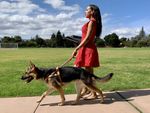 Guide dogs don’t lead blind people. We wander as oneMy guide dog crossed the street, then jerked to a halt. "Mylo, forward." My left hand held the leather harness that wrapped around his shoulders. "Forward," I repeated. The harness shifted, and I knew he was peering back at me. Some barrier, unseen and unheard by me, blocked our passage. Cars created little earthquakes in...
Guide dogs don’t lead blind people. We wander as oneMy guide dog crossed the street, then jerked to a halt. "Mylo, forward." My left hand held the leather harness that wrapped around his shoulders. "Forward," I repeated. The harness shifted, and I knew he was peering back at me. Some barrier, unseen and unheard by me, blocked our passage. Cars created little earthquakes in... -
 My Book is in Stores Now, and it’s getting great reviews!The Today Show featured my book on Monday, and the video of my interview is now online. For an in-depth review, The Wall Street Journal published this excellent piece on my book and work. And there's more! The New York Times' list of New and Noteworthy releases included my book! This terrific taste in books...
My Book is in Stores Now, and it’s getting great reviews!The Today Show featured my book on Monday, and the video of my interview is now online. For an in-depth review, The Wall Street Journal published this excellent piece on my book and work. And there's more! The New York Times' list of New and Noteworthy releases included my book! This terrific taste in books... -
 Mylo and I Imagine Driving an Autonomous CarI'm excited for a future where accessible self-driving cars are a reality. People with disabilities stand to benefit the most from self-driving cars, but developers are not making accessibility enough of a priority. Waiting until a product is "finished" to start thinking about accessibility is like completing construction of a skyscraper and then tearing part...
Mylo and I Imagine Driving an Autonomous CarI'm excited for a future where accessible self-driving cars are a reality. People with disabilities stand to benefit the most from self-driving cars, but developers are not making accessibility enough of a priority. Waiting until a product is "finished" to start thinking about accessibility is like completing construction of a skyscraper and then tearing part... -
My new book received a glowing review!After writing, editing, and rewriting for over two years, I'm thrilled to bring this book into the world. Publishers Weekly, the insider's guide to the book world, released an enthusiastic review: "With wit and passion, Haben, a disability rights lawyer, public speaker, and the first deafblind person to graduate from Harvard Law, takes readers through...
-
 World Braille DayCelebrating the 210th birthday of Louis Braille, a brilliant teacher who developed a tactile reading system. Blind children and adults learned to uncover the treasure trove of knowledge stored in books through our fingers. We continued innovating, and now we also have digital braille to read articles, websites, & apps. Happy birthday, Louis Braille!
World Braille DayCelebrating the 210th birthday of Louis Braille, a brilliant teacher who developed a tactile reading system. Blind children and adults learned to uncover the treasure trove of knowledge stored in books through our fingers. We continued innovating, and now we also have digital braille to read articles, websites, & apps. Happy birthday, Louis Braille! -
![Video: Haben's Seeing Eye Dog Watches Her Surf in Hawaii]() Surfing in HawaiiSurfing as a Deafblind person feels like I'm alone with the ocean. The exhilaration of connecting with such a powerful force of nature is unlike anything else I've experienced. My whole body listens to the ocean through the board, constantly adjusting as it tilts and sways. I can't see where the ocean takes me, but...
Surfing in HawaiiSurfing as a Deafblind person feels like I'm alone with the ocean. The exhilaration of connecting with such a powerful force of nature is unlike anything else I've experienced. My whole body listens to the ocean through the board, constantly adjusting as it tilts and sways. I can't see where the ocean takes me, but... -
 Haben Meets with the Hawaii Deafblind CommunityHawaii's Deafblind community held a "Talk Story" where we shared our experiences. Thank you to everyone for the warm welcome, and a special thank you to Mellanie Lee for bringing us all together.
Haben Meets with the Hawaii Deafblind CommunityHawaii's Deafblind community held a "Talk Story" where we shared our experiences. Thank you to everyone for the warm welcome, and a special thank you to Mellanie Lee for bringing us all together. -
A Service Dog Holiday SongMylo visited a beach for the first time this week, and the experience inspired a new spin on a holiday classic: Dashing through the sand My guide dog will never stray Harness in my hand Laughing all the way Collar tags bounce and ring Large waves roll ashore A four-legged pal can always bring A...
-
I’m asking Texas to keep Helen Keller’s story in the K-12 curriculumLast week the Texas State Board of Education took a step to remove Helen Keller from the K-12 social studies curriculum. The second largest state in the nation may soon stop teaching students about one of the most widely admired disability rights heroes. She is often the only disability rights advocate kids learn about. Kids...
-
Hey, Texas. Students need to learn about Helen Keller. Don’t remove herI am Deaf-blind, and I almost missed my first lesson about Helen Keller. In second-grade U.S. history, my teacher scheduled Helen Keller's story after a lesson in square-dancing. I remember my heart racing as I danced a do-si-do with my not-so-secret crush. So when our teacher told us about Keller, I was not-so-secretly distracted. But...
-
 It’s a boy! Meet Mylo, my new Seeing Eye dog"You just came back from dog jail, huh?" Aunt Nunu nudged my arm. I laughed. "Exactly!" I'd just spent three weeks training at The Seeing Eye, the world's oldest guide dog school. "We had to wake up every morning to take our dogs out at 5:30 AM." "Are you kidding me?!" "I wish. We worked...
It’s a boy! Meet Mylo, my new Seeing Eye dog"You just came back from dog jail, huh?" Aunt Nunu nudged my arm. I laughed. "Exactly!" I'd just spent three weeks training at The Seeing Eye, the world's oldest guide dog school. "We had to wake up every morning to take our dogs out at 5:30 AM." "Are you kidding me?!" "I wish. We worked... -
 Voice, Sign, Type: The Lively Communication DanceMy friend Treshelle Edmond is a Deaf actress and phenomenal communicator. We met up after her performance in "Children of a Lesser God," now playing on Broadway. The play spotlights Deaf culture, and many Deaf actors, directors, and community members contributed to the show's success. Treshelle introduced me to her friends. One after another, each...
Voice, Sign, Type: The Lively Communication DanceMy friend Treshelle Edmond is a Deaf actress and phenomenal communicator. We met up after her performance in "Children of a Lesser God," now playing on Broadway. The play spotlights Deaf culture, and many Deaf actors, directors, and community members contributed to the show's success. Treshelle introduced me to her friends. One after another, each... -
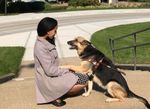 Maxine, the sweetest, smartest, sneakiest Seeing Eye DogMaxine, the sweetest, smartest, sneakiest Seeing Eye Dog died on Monday April 16, 2018. Maxine loved wearing her harness and going on adventures. If I wanted to walk with her, though, I had to earn that right. In our first week together she crashed me into planters, chairs, and even stairs. "It takes time to...
Maxine, the sweetest, smartest, sneakiest Seeing Eye DogMaxine, the sweetest, smartest, sneakiest Seeing Eye Dog died on Monday April 16, 2018. Maxine loved wearing her harness and going on adventures. If I wanted to walk with her, though, I had to earn that right. In our first week together she crashed me into planters, chairs, and even stairs. "It takes time to... -
 The Helen Keller Achievement AwardOn April 4, the American Foundation for the Blind presented me with the Helen Keller Achievement Award! Helen Keller has had a huge influence on my life --- her books, her advocacy, and especially her incredible spirit. Receiving this award is a tremendous honor. I'm determined to devote my life to advocacy, just like Helen....
The Helen Keller Achievement AwardOn April 4, the American Foundation for the Blind presented me with the Helen Keller Achievement Award! Helen Keller has had a huge influence on my life --- her books, her advocacy, and especially her incredible spirit. Receiving this award is a tremendous honor. I'm determined to devote my life to advocacy, just like Helen.... -
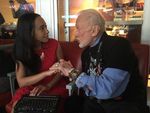 Houston, Prepare for Astronauts with DisabilitiesChris Hadfield is a retired Canadian astronaut and former commander of the International Space Station. During one critical spacewalk, floating anti-fog got into Hadfield's eyes, making him temporarily blind. Later, in his TED talk , Hadfield described his thought process: "Okay, I can't see, but I can hear, I can talk, Scott Parazynski is out...
Houston, Prepare for Astronauts with DisabilitiesChris Hadfield is a retired Canadian astronaut and former commander of the International Space Station. During one critical spacewalk, floating anti-fog got into Hadfield's eyes, making him temporarily blind. Later, in his TED talk , Hadfield described his thought process: "Okay, I can't see, but I can hear, I can talk, Scott Parazynski is out... -
People with Disabilities Drive InnovationUnbeknown to most employers, people with disabilities sparked the creation of many of the technologies we use today. Through my work as a disability rights lawyer, and my personal experiences as a deafblind woman, I have spent a significant amount of time studying the disability experience. The biggest barriers in the workplace are architectural, digital...
-
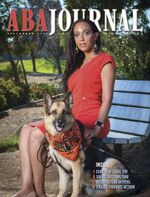 Maxine Makes the Cover of the ABA Journal!Maxine, the little legal rebel, is on the cover of the ABA Journal! It's America's leading legal affairs magazine. ABA journalist Stephanie Ward wrote this wonderful article about my disability rights work. Image Description : Maxine, a German Shepherd guide dog, sits front and center. Around her neck is an orange bandana that says, "Legal...
Maxine Makes the Cover of the ABA Journal!Maxine, the little legal rebel, is on the cover of the ABA Journal! It's America's leading legal affairs magazine. ABA journalist Stephanie Ward wrote this wonderful article about my disability rights work. Image Description : Maxine, a German Shepherd guide dog, sits front and center. Around her neck is an orange bandana that says, "Legal... -
Videos: Black Girls Rock Making A Difference AwardBET and Black Girls Rock produced an amazing video celebrating my disability rights work. If you missed it on TV yesterday, you can watch it here . Also, here's the video of actress Rutina Wesley honoring me with the Making A Difference Award. This award would not be possible without an incredible community of family...
-
 Excited to be on the Black Girls Rock Awards ShowI'm excited to announce that I will be on the Black Girls Rock Awards Show. Black Girls Rock is honoring me for Making A Difference. Solange, Congresswoman Maxine Waters, Issa Rae, Roberta Flack, Yara Shahidi, Ibtihaj Muhammad, Augusta Uwamanzu-Nna, and many other amazing women will be celebrated. Tune in to BET, the Black Entertainment Television...
Excited to be on the Black Girls Rock Awards ShowI'm excited to announce that I will be on the Black Girls Rock Awards Show. Black Girls Rock is honoring me for Making A Difference. Solange, Congresswoman Maxine Waters, Issa Rae, Roberta Flack, Yara Shahidi, Ibtihaj Muhammad, Augusta Uwamanzu-Nna, and many other amazing women will be celebrated. Tune in to BET, the Black Entertainment Television... -
![Video: Calming Fears & Sparking Connections with the Abilities We Have | Haben Girma]() Calming Fears & Sparking Connections with the Abilities We HaveMy deafblindness can be isolating, so I actively develop ways to connect with people. One solution is to offer people a keyboard paired with my braille computer, and as they type I'm able to easily read their words in braille. But what if a person who wants to talk to me has dyslexia? During the...
Calming Fears & Sparking Connections with the Abilities We HaveMy deafblindness can be isolating, so I actively develop ways to connect with people. One solution is to offer people a keyboard paired with my braille computer, and as they type I'm able to easily read their words in braille. But what if a person who wants to talk to me has dyslexia? During the... -
 An Interview with CJ Jones, the Deaf Actor in the Hot New Movie ‘Baby Driver’I was excited to learn that the Deaf character in the summer hit Baby Driver is actually played by a Deaf actor. This may signal a positive shift in Hollywood. Historically, most of the disabled characters in films were played by non-disabled actors, and a study by the Ruderman Family Foundation found that 95% of...
An Interview with CJ Jones, the Deaf Actor in the Hot New Movie ‘Baby Driver’I was excited to learn that the Deaf character in the summer hit Baby Driver is actually played by a Deaf actor. This may signal a positive shift in Hollywood. Historically, most of the disabled characters in films were played by non-disabled actors, and a study by the Ruderman Family Foundation found that 95% of... -
 Prime Minister Justin Trudeau Welcomes Haben to OttawaThe Eritrean Youth Initiative (EYI) invited me to Ottawa to keynote their inaugural fundraiser dinner. The sold-out event on June 24th raised scholarships for high school students heading to college. My friend Negash Haile and his colleagues at EYI brought together Canadians from diverse backgrounds to recognize students making a difference. Prime Minister Justin Trudeau...
Prime Minister Justin Trudeau Welcomes Haben to OttawaThe Eritrean Youth Initiative (EYI) invited me to Ottawa to keynote their inaugural fundraiser dinner. The sold-out event on June 24th raised scholarships for high school students heading to college. My friend Negash Haile and his colleagues at EYI brought together Canadians from diverse backgrounds to recognize students making a difference. Prime Minister Justin Trudeau... -
GOOD Magazine Features Haben’s StoryA Deaf-Blind Lawyer Wants to Know Why Surfboards Are Safer Than Classrooms
-
![Video: Haben Dome-Climbing at the City Museum of St. Louis]() Exploring Museum Accessibility in St. LouisHere's a fun video of me exploring the City Museum in St. Louis. Climbing the giant dome at the City Museum, every step brought a fun surprise! Because I'm Deafblind I climbed by touch. Also, my guide dog can't climb ladders...yet! :) I visited the City Museum while in St. Louis last month to serve...
Exploring Museum Accessibility in St. LouisHere's a fun video of me exploring the City Museum in St. Louis. Climbing the giant dome at the City Museum, every step brought a fun surprise! Because I'm Deafblind I climbed by touch. Also, my guide dog can't climb ladders...yet! :) I visited the City Museum while in St. Louis last month to serve... -
![Video: Haben Girma speaks at the 2017 Annual Meeting & MuseumExpo]() Haben Girma's Keynote at the 2017 Annual Meeting & MuseumExpo for the American Alliance of MuseumsDescriptive Transcript (audience applause) Good morning. [Audience] Good morning. Thank you to Sam for that wonderful introduction. I also want to say thank you to Andrea Streat for welcoming me here and helping me share my story with this community. As Sam mentioned, I'm deaf-blind, so I can't see audience members, and I can't really...
Haben Girma's Keynote at the 2017 Annual Meeting & MuseumExpo for the American Alliance of MuseumsDescriptive Transcript (audience applause) Good morning. [Audience] Good morning. Thank you to Sam for that wonderful introduction. I also want to say thank you to Andrea Streat for welcoming me here and helping me share my story with this community. As Sam mentioned, I'm deaf-blind, so I can't see audience members, and I can't really... -
 Haben Receives the Secret Strength AwardSecret honored Haben with the Secret Strength Award on February 4, 2017 during the Super Bowl's NFL Women's Summit. Supporting Deaf women studying to become advocates, Secret will also donate $10,000 to Deaf Legal Advocacy Worldwide, a nonprofit helping Deaf students excel in law school. Thank you, Secret!
Haben Receives the Secret Strength AwardSecret honored Haben with the Secret Strength Award on February 4, 2017 during the Super Bowl's NFL Women's Summit. Supporting Deaf women studying to become advocates, Secret will also donate $10,000 to Deaf Legal Advocacy Worldwide, a nonprofit helping Deaf students excel in law school. Thank you, Secret! -
 Haben is Now an Author with Grand Central PublishingWe're excited to announce that Haben is now an Author with Grand Central Publishing. We just signed a book deal. Over the next two years Haben will be working on her first book, a memoir.
Haben is Now an Author with Grand Central PublishingWe're excited to announce that Haben is now an Author with Grand Central Publishing. We just signed a book deal. Over the next two years Haben will be working on her first book, a memoir. -
Haben Featured on NBC’s OxygenDeaf-Blind Harvard Law Grad Slays Every Expectation, But Don't Call Her An "Inspiration"
-
A Brief Disability Accessibility GuideAll of our bodies change over time. We all deserve dignity and access at every stage in our lives. Most people will need to seek accessibility solutions at some point, whether for a family member, a colleague, or for oneself. Disability is part of the human experience. We all need to engage in the work...
-
![Video: Disability & Innovation: The Universal Benefits of Accessible Design, by Haben Girma @ WWDC 2016]() Disability & Innovation: The Universal Benefits of Accessible Design by Haben Girma @ Apple’s WWDC 2016Descriptive Transcript [ Music ] Felice: Ladies and gentlemen, please join me in welcoming on stage, Haben Girma. [ Applause ] Haben: Good afternoon. Thank you for the introduction, Felice. My name is Haben Girma. I work as an accessibility and inclusion advocate, teaching organizations and individuals to design with accessibility in mind. I'm Deafblind....
Disability & Innovation: The Universal Benefits of Accessible Design by Haben Girma @ Apple’s WWDC 2016Descriptive Transcript [ Music ] Felice: Ladies and gentlemen, please join me in welcoming on stage, Haben Girma. [ Applause ] Haben: Good afternoon. Thank you for the introduction, Felice. My name is Haben Girma. I work as an accessibility and inclusion advocate, teaching organizations and individuals to design with accessibility in mind. I'm Deafblind.... -
![Video: Haben is standing at the St. Catherine University podium wearing academic regalia, and behind her is a US flag.]() Haben Awarded the Alexandrine Medal and Delivers Commencement Address at St. Catherine UniversitySt. Catherine University honored Haben Girma with the Alexandrine Medal on May 22, 2016. Named after the Egyptian scholar Catherine of Alexandria, St. Catherine University awards the Alexandrine Medal to women who demonstrate an outstanding commitment to public service. Past recipients include Dorothy Day, Ann Bancroft, and Maya Angelou. Haben is the youngest person to...
Haben Awarded the Alexandrine Medal and Delivers Commencement Address at St. Catherine UniversitySt. Catherine University honored Haben Girma with the Alexandrine Medal on May 22, 2016. Named after the Egyptian scholar Catherine of Alexandria, St. Catherine University awards the Alexandrine Medal to women who demonstrate an outstanding commitment to public service. Past recipients include Dorothy Day, Ann Bancroft, and Maya Angelou. Haben is the youngest person to... -
![Video: President Bill Clinton Honors Haben Girma at CGI U 2016]() President Bill Clinton Honors Haben GirmaI met with President Bill Clinton before my keynote address at the 2016 Clinton Global Initiative University. Here's what he said the following day: President Bill Clinton : I don't want to embarrass her, but sitting over here on the front row, is a young woman who graduated from Harvard Law School, without the ability...
President Bill Clinton Honors Haben GirmaI met with President Bill Clinton before my keynote address at the 2016 Clinton Global Initiative University. Here's what he said the following day: President Bill Clinton : I don't want to embarrass her, but sitting over here on the front row, is a young woman who graduated from Harvard Law School, without the ability... -
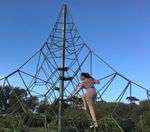 Announcing a Career ChangeThere's only one way to get to the top of a ladder, but there are many ways to get to the top of a jungle gym... The ability to forge a unique path with occasional dips, detours and even dead ends presents a better chance for fulfillment. Sheryl Sandberg, Lean In . [Choosing to change...
Announcing a Career ChangeThere's only one way to get to the top of a ladder, but there are many ways to get to the top of a jungle gym... The ability to forge a unique path with occasional dips, detours and even dead ends presents a better chance for fulfillment. Sheryl Sandberg, Lean In . [Choosing to change... -
Pacific Standard: The 30 Top Thinkers Under 30: Haben GirmaHaben Girma is deaf-blind, and the first such person to have graduated from Harvard Law School. Now, she's using her law degree to make sure the Internet is as surf-able for people like her as it is for people who can see and hear. Raised by refugee parents from Eritrea and Ethiopia, Haben grew up...
-
Interview: Deafblind Attorney Fights for Online AccessibilityFrom the Ruderman Family Foundation: Haben Girma, a disability advocate and the first deafblind graduate of Harvard Law School, spoke with us via iMessage from her Berkeley, CA, office to discuss her work to change the accessibility culture of Silicon Valley, her meeting with President Obama during the 25th anniversary commemoration of the Americans with...
-
Washington Post: Deaf-blind Harvard-trained lawyer who made waves now rides them, tooExcerpt : Eritrean American Haben Girma is used to pushing boundaries. She made waves as the first-ever deaf-blind graduate of Harvard Law School, and quickly joined Disability Rights Advocates after her graduation in 2013 to work for increased accessibility and acceptance for disabled Americans. She was honored by the White House and gave a moving...
-
Haben featured on Forbes 30 under 30Haben Girma is a first generation immigrant, and the first deaf and blind student to graduate from Harvard Law School. She helped achieve a legal victory in National Federal of the Blind v. Scribd, the second case to hold that the Americans With Disabilities Act applies to e-commerce. She is a staff attorney at Disability...
-
Chambers Associate: 5 Minutes with HabenExcerpt : When did you decide to become a lawyer? Why? As a Deafblind student in college, I witnessed advocates using the Americans with Disabilities Act (ADA) to change social attitudes. The National Federation of the Blind regularly referenced the ADA when explaining to technology developers why designing access for people with disabilities is a...
-
![Video: Deafblind Lawyer, Dancer & Surfer Haben Girma Named a Hero by BBC]() Deafblind Lawyer, Dancer & Surfer Haben Girma Named a Hero by BBCEritrean-American lawyer Haben Girma was the first deaf-blind graduate of Harvard Law School. Today she's a lawyer at Disability Rights Advocates, a accessible technology campaigner and a keen surfer. She's also our sixth #WomenOfAfrica unsung hero. BBC Women of Africa Series Full interview transcript I grew up facing access barriers as a deafblind person, and...
Deafblind Lawyer, Dancer & Surfer Haben Girma Named a Hero by BBCEritrean-American lawyer Haben Girma was the first deaf-blind graduate of Harvard Law School. Today she's a lawyer at Disability Rights Advocates, a accessible technology campaigner and a keen surfer. She's also our sixth #WomenOfAfrica unsung hero. BBC Women of Africa Series Full interview transcript I grew up facing access barriers as a deafblind person, and... -
![Video: Deafblind Daughter of an Eritrean Refugee, Now a Lawyer, Discusses Meeting Obama]() Deafblind Daughter of an Eritrean Refugee, Now a Lawyer, Discusses Meeting ObamaBBC Women of Africa Series: Haben Girma was the first deaf-blind student to graduate from Harvard Law School. Today the Eritrean-American fights for better education for deaf-blind people worldwide. Plain text transcript Transcript [Video opens with photos of African women and lively music. Music ends with the words: "Women of Africa: Africa's Unsung Heroes" under...
Deafblind Daughter of an Eritrean Refugee, Now a Lawyer, Discusses Meeting ObamaBBC Women of Africa Series: Haben Girma was the first deaf-blind student to graduate from Harvard Law School. Today the Eritrean-American fights for better education for deaf-blind people worldwide. Plain text transcript Transcript [Video opens with photos of African women and lively music. Music ends with the words: "Women of Africa: Africa's Unsung Heroes" under... -
![Video: Designing Accessible Technology | Haben Girma | Talks at Google]() Haben speaks at Google: “Designing Technology with Accessibility in Mind”Transcript FEMALE SPEAKER: Welcome, everybody. Please join us in welcoming Haben Girma today to Google. She is a Harvard Law graduate, the first deaf-blind graduate from Harvard Law School. And she is a pioneer in everything that has to do with technology for accessibility. So she has been helping a very, very in depth with...
Haben speaks at Google: “Designing Technology with Accessibility in Mind”Transcript FEMALE SPEAKER: Welcome, everybody. Please join us in welcoming Haben Girma today to Google. She is a Harvard Law graduate, the first deaf-blind graduate from Harvard Law School. And she is a pioneer in everything that has to do with technology for accessibility. So she has been helping a very, very in depth with... -
White House Blog: My ADA Story: A Deafblind Lawyer Dismantling Digital BarriersMy ADA Story: A Deafblind Lawyer Dismantling Digital Barriers The President shared a moving story of how, in the years before Congress passed the ADA, his father-in-law --- who had multiple sclerosis --- would sometimes hold himself back because he didn't want his disability to inconvenience others. With that story, President Obama reminded Americans that...
-
Haben featured on NPRShe Owes Her Activism To A Brave Mom, The ADA And Chocolate Cake To Haben Girma's grandmother, back in East Africa, it "seemed like magic." Her granddaughter, born deaf and blind, is a graduate of Harvard Law School and works as a civil rights attorney. It's easy to understand why the grandmother feels that way....
-
![Video: President Obama Celebrates the 25th Anniversary of the ADA]() President Obama, Haben Girma, and Alice Wong highlight how technology empowers people with disabilitiesTranscript HABEN GIRMA: I hope to use the technology to help teach others that technology can bridge the gap for people with disabilities, and as internet services open more opportunities for people, we're going to see more people with disabilities employed and succeeding. (The President hugs Haben) HABEN: Thanks for supporting us. THE PRESIDENT (typing):...
President Obama, Haben Girma, and Alice Wong highlight how technology empowers people with disabilitiesTranscript HABEN GIRMA: I hope to use the technology to help teach others that technology can bridge the gap for people with disabilities, and as internet services open more opportunities for people, we're going to see more people with disabilities employed and succeeding. (The President hugs Haben) HABEN: Thanks for supporting us. THE PRESIDENT (typing):... -
![Video: Presidential Remarks on the 25th Anniversary of the Americans with Disabilities Act (C-SPAN)]() Haben’s White House RemarksHaben had the honor of introducing President Barack Obama and Vice President Joe Biden at the White House 25th Anniversary Celebration of the Americans with Disabilities Act. Transcript HABEN: Good afternoon! (Good afternoon!) My name is Haben Girma. Allow me to share a story. When my grandmother took my older brother to school in East...
Haben’s White House RemarksHaben had the honor of introducing President Barack Obama and Vice President Joe Biden at the White House 25th Anniversary Celebration of the Americans with Disabilities Act. Transcript HABEN: Good afternoon! (Good afternoon!) My name is Haben Girma. Allow me to share a story. When my grandmother took my older brother to school in East... -
![Video: Haben meeting with Tedros Adhanom]() Ethiopia: A Disability Rights Movement Rich with HistoryAster Zaoude, a former United Nations leader for gender equality and women's empowerment, discovered one of my articles on her Facebook news feed. Excited to share my message with the disability community in Ethiopia, she generously invited me to visit Ethiopia and provide presentations there. Aster organized an ambitious agenda that included TV interviews, presentations...
Ethiopia: A Disability Rights Movement Rich with HistoryAster Zaoude, a former United Nations leader for gender equality and women's empowerment, discovered one of my articles on her Facebook news feed. Excited to share my message with the disability community in Ethiopia, she generously invited me to visit Ethiopia and provide presentations there. Aster organized an ambitious agenda that included TV interviews, presentations... -
Haben Elected to the Board of Trustees of Helen Keller Services for the BlindDeaf, blind Berkeley resident appointed to national organization's board of trustees
-
![Video: Haben Girma at Meet EBC with Tefera Gedamu on Ethiopian TV [Excerpt]]() Haben Girma at Meet EBC with Tefera Gedamu on Ethiopian TV [Excerpt]Terrific TV host Tefera Gedamu invites Haben Girma to discuss her visit to Ethiopia on his popular show Meet EBC. Haben is an attorney with Disability Rights Advocates. In December 2014 she met with students and disability rights leaders in Ethiopia. This excerpt from her interview with Tefera begins with Tefera typing his questions to...
Haben Girma at Meet EBC with Tefera Gedamu on Ethiopian TV [Excerpt]Terrific TV host Tefera Gedamu invites Haben Girma to discuss her visit to Ethiopia on his popular show Meet EBC. Haben is an attorney with Disability Rights Advocates. In December 2014 she met with students and disability rights leaders in Ethiopia. This excerpt from her interview with Tefera begins with Tefera typing his questions to... -
Haben Shares her story volunteering abroad for students with disabilitiesFrom the article: ["Growing up, Haben Girma knew that international exchange was bound to be in her future. She had visited Eritrea and Ethiopia, places her parents called home before immigrating to the United States.]{.s1} [So when Haben learned about BuildOn as a teenager, she was determined to go. She was excited about BuildOn's mission...
-
Above The Law article on how Haben uses technology at DRAToday's Tech: How A Deaf-Blind Lawyer Uses Technology To Represent Her Disabled Clients
-
International Telecommunications Blog, Haben Discusses Mainstreaming Technology[Mainstreaming Accessibility: Deafblindness, Assistive Technology And Advocacy]{.s1}
-
Eyes on Success featuring Haben’s work at DRATranscript (synthetic voice): Hello and welcome to Eyes on Success, a weekly program of information on the ever changing world of accessibility. Now here are the hosts of this program, Nancy Goodman Torpey and Peter Torpey. N: Hello, I'm Nancy. P: And I'm Pete. This week we will be talking with a deaf-blind attorney who...
-
Beautiful Column in the Columbus Dispatch: This Champion of Change is Just Getting Warmed UpDeborah Kendrick commentary: This Champion of Change is just getting warmed up | The Columbus Dispatch
-
Haben featured on The Daily BeastHaben talks about her life, legal work and TEDx accessibility in an interview published in The Daily Beast: TEDx Talks Have a Disability Problem---but This Incredible Young Woman Is Working to Change That
-
Business Insider Features Haben and DRA’s work on Scribd lawsuitFrom the article: "A deaf-blind attorney who made Business Insider's 2013 list of the 20 most impressive Harvard Law students is now fighting for the rights of blind readers in a lawsuit against digital subscription reading service Scribd , seeking equal access for the blind. Haben Girma made Business Insider's 2013 list for her work...
-
San Francisco Foundation Article on Haben’s work with Disability Rights AdvocatesDisability Rights Advocates: All Grown Up And Not Backing Down
-
Haben recognized by National Association of the Deaf, receives July #NADHandwaveJuly 2014 #NADHandwave | National Association of the Deaf
-
American Bar Association highlights Haben’s workThe Journey from Self-Advocate to Legal Advocate to Educator
-
![Video: Why I work to remove access barriers for students with disabilities | Haben Girma | TEDxBaltimore]() TEDx Talk: Why I work to remove access barriers for students with disabilitiesHaben speaks at TEDx Baltimore 2014 on her education and experiences with a nonprofit where she used to work. Transcript My name is Haben Girma. I work as a Skadden Fellow at Disability Rights Advocates. In other words, I'm a lawyer. What's a lawyer? Well, there are many stereotypes, negative stereotypes of lawyers: People who...
TEDx Talk: Why I work to remove access barriers for students with disabilitiesHaben speaks at TEDx Baltimore 2014 on her education and experiences with a nonprofit where she used to work. Transcript My name is Haben Girma. I work as a Skadden Fellow at Disability Rights Advocates. In other words, I'm a lawyer. What's a lawyer? Well, there are many stereotypes, negative stereotypes of lawyers: People who... -
The Virgin Islands: People with Disabilities in a Tropical Paradise?Blessed with warm white-sand beaches, beautiful views of mountains and the Caribbean Sea, the U.S. Virgin Islands draw tourists from around the world. For people with disabilities who visit or live in the Virgin Islands, to what extent does the place actually feel like paradise? About 40 miles West of Puerto Rico, several hundred miles...
-
![Video: Harvard Law Speaks: Disability Rights Lawyers Harnessing Technology]() Harvard Law Speaks 2013, Harvard Law SchoolThe greatest lawyers embrace the role of community educators whose effectiveness is bolstered by the potential for litigation. For example, blind students who once had limited access to books can now potentially access thousands of books through digital bookstores and libraries that have been made accessible. Many schools are unaware of the need for accessibility,...
Harvard Law Speaks 2013, Harvard Law SchoolThe greatest lawyers embrace the role of community educators whose effectiveness is bolstered by the potential for litigation. For example, blind students who once had limited access to books can now potentially access thousands of books through digital bookstores and libraries that have been made accessible. Many schools are unaware of the need for accessibility,... -
Haben Girma: Launching a career at the intersection of law, education and civil rights (Harvard Law Bulletin)Original Article : Haben Girma: Launching a career at the intersection of law, education and civil rights
-
China: Striving for More Inclusive CommunitiesRenmin University of China had never seen anything like it before. Judging from the countless people who gleefully snapped photos of us around the Forbidden City, people in Beijing had never seen anything like it before. Renmin students and Chinese tourists all seemed surprised to see two confident blind Americans. Haben Girma and Tai Blas,...
-
Haben is Named a White House Champion of ChangeThe White House recognized Haben Girma as a Champion of Change on February 26, 2013. The White House Champions of Change Program honors ordinary Americans doing extraordinary things, and this week's Champions have taken extraordinary strides for America's students. Haben and nine other Champions discussed important changes in education that would help students across the...
-
After Helen Keller: Empowering Students with DisabilitiesDedicated teachers are essential to a good quality education, especially for students with disabilities. I strive to kindle the passion of those who have chosen this sometimes stressful yet incredibly valuable career, and inspire students to learn the secret to success that is self-advocacy. In November I gave a keynote at the North Carolina Conference...
-
Advocating for Others Starts with YourselfPerkins President Steven Rothstein concluded the Martin Luther King, Jr. Day assembly, on Jan. 16, 2012, with a call to action. "Civil rights is up to all of you," he said. "Don't wait for the next Martin Luther King Jr. or Helen Keller; freedom must be demanded by the oppressed." Yet he acknowledged every movement...
-
![Video: Haben Girma's MLK Day Speech at the Perkins School for the Blind]() MLK Day Speech at the Perkins School for the BlindThank you for having me here today. Some of the most well-known disability rights advocates have passed through the Perkins School for the Blind, most famous, of course, were Helen Keller and Anne Sullivan. They left Perkins intent on making the world a better place. Since that time, laws have been created to ensure that...
MLK Day Speech at the Perkins School for the BlindThank you for having me here today. Some of the most well-known disability rights advocates have passed through the Perkins School for the Blind, most famous, of course, were Helen Keller and Anne Sullivan. They left Perkins intent on making the world a better place. Since that time, laws have been created to ensure that... -
![Video: Haben Girma's Keynote at OSEP's Project Directors Conference]() Keynote at OSEP’s Project Directors ConferenceWorking to improve education for students with disabilities is important to me. My knowledge of special education has expanded through this summer's internship with the US Department of Education's Office for Civil Rights. A good quality education propels children towards productive adult lives. Throughout my educational journey, from elementary school in Oakland, California to law...
Keynote at OSEP’s Project Directors ConferenceWorking to improve education for students with disabilities is important to me. My knowledge of special education has expanded through this summer's internship with the US Department of Education's Office for Civil Rights. A good quality education propels children towards productive adult lives. Throughout my educational journey, from elementary school in Oakland, California to law... -
![Video: Haben's IDEA Speech]() IDEA SpeechGood Afternoon, my name is Haben Girma. I live with both vision and hearing loss, and have been deafblind since about age five. When my parents enrolled me in the Oakland Public School District in California, IDEA had been influencing the education of students with disabilities for nearly twenty years. My parents did not have...
IDEA SpeechGood Afternoon, my name is Haben Girma. I live with both vision and hearing loss, and have been deafblind since about age five. When my parents enrolled me in the Oakland Public School District in California, IDEA had been influencing the education of students with disabilities for nearly twenty years. My parents did not have... -
![Video: Haben Girma's BuildOn Speech]() BuildOn SpeechThe Saharan sun attacked my sunscreened skin. The 130-degree temperature was almost unbearable. I bent over and shoveled sand repeatedly, until exhaustion forced me to pass the shovel to the next member of my team. I had come to West Africa to help build a school for 800 children eager to learn. These eighteen days...
BuildOn SpeechThe Saharan sun attacked my sunscreened skin. The 130-degree temperature was almost unbearable. I bent over and shoveled sand repeatedly, until exhaustion forced me to pass the shovel to the next member of my team. I had come to West Africa to help build a school for 800 children eager to learn. These eighteen days...




















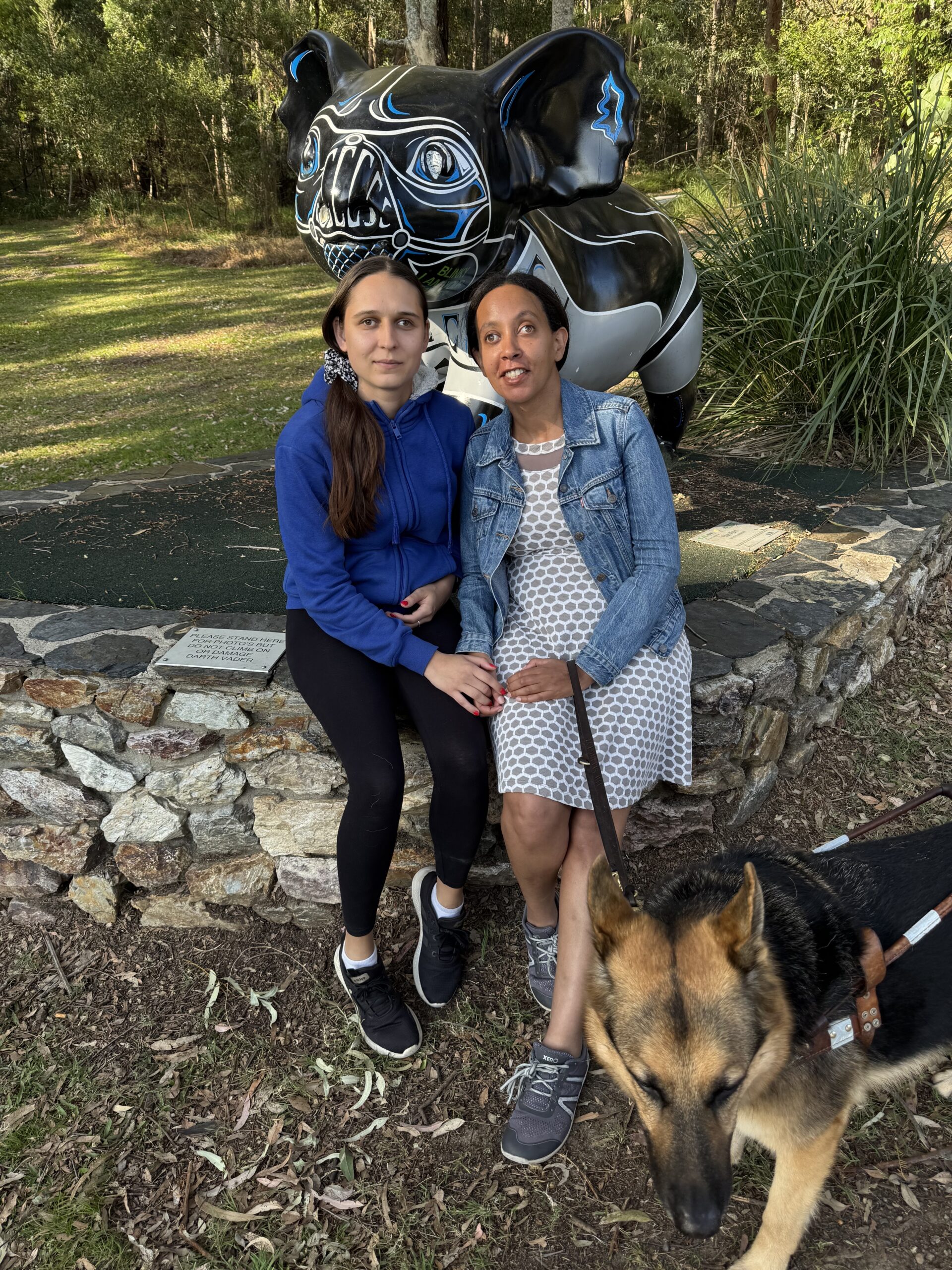
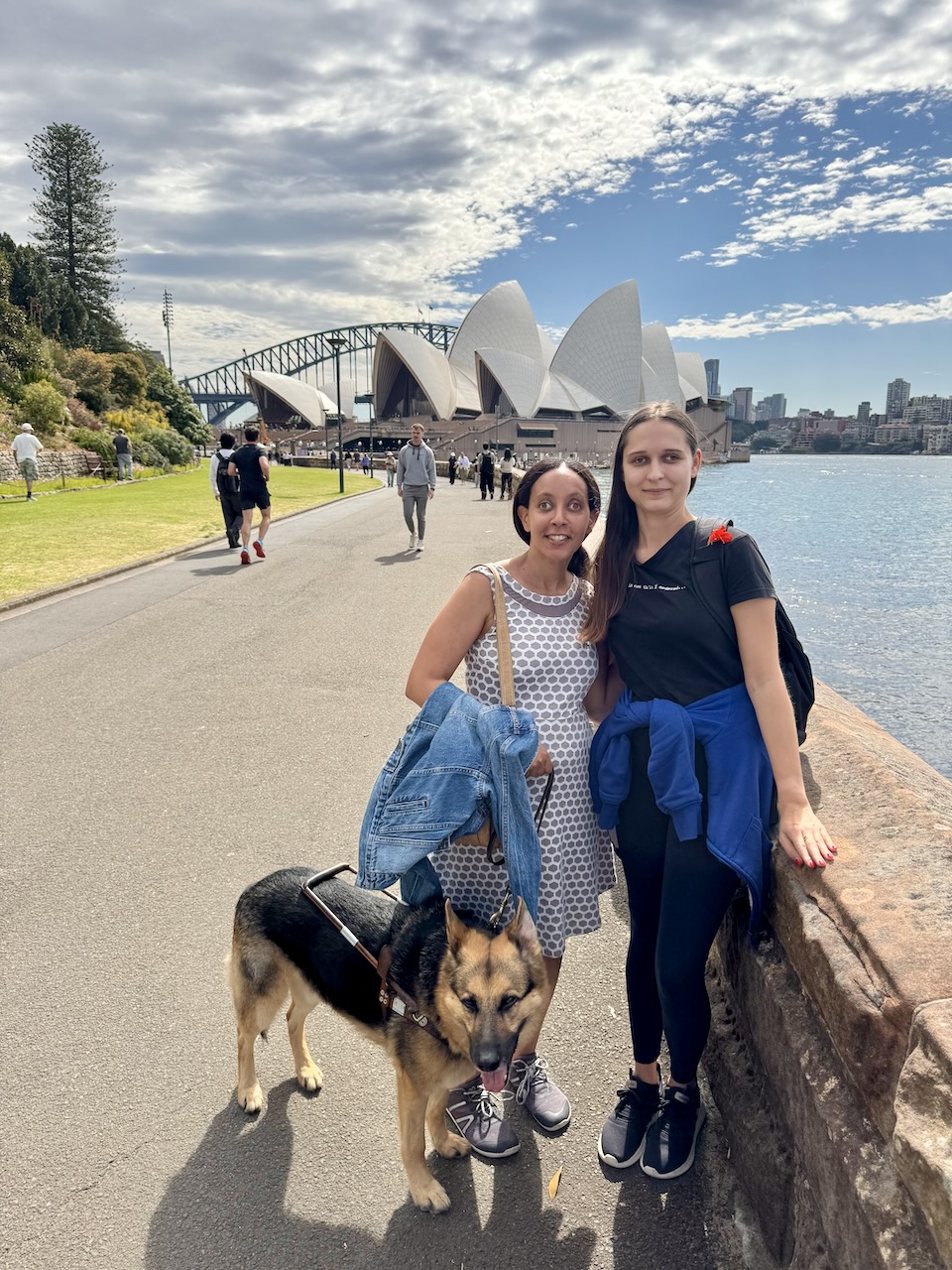

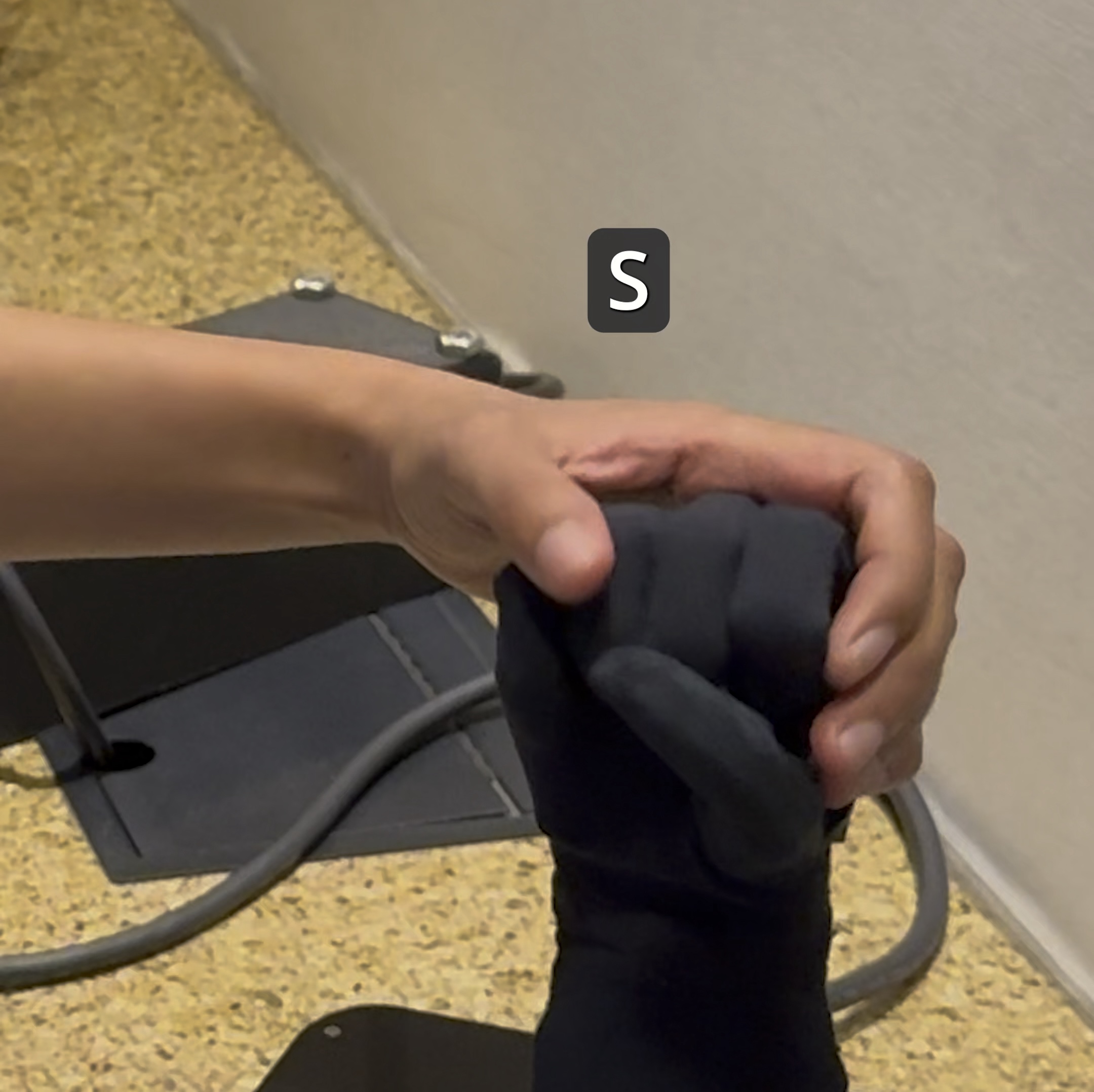









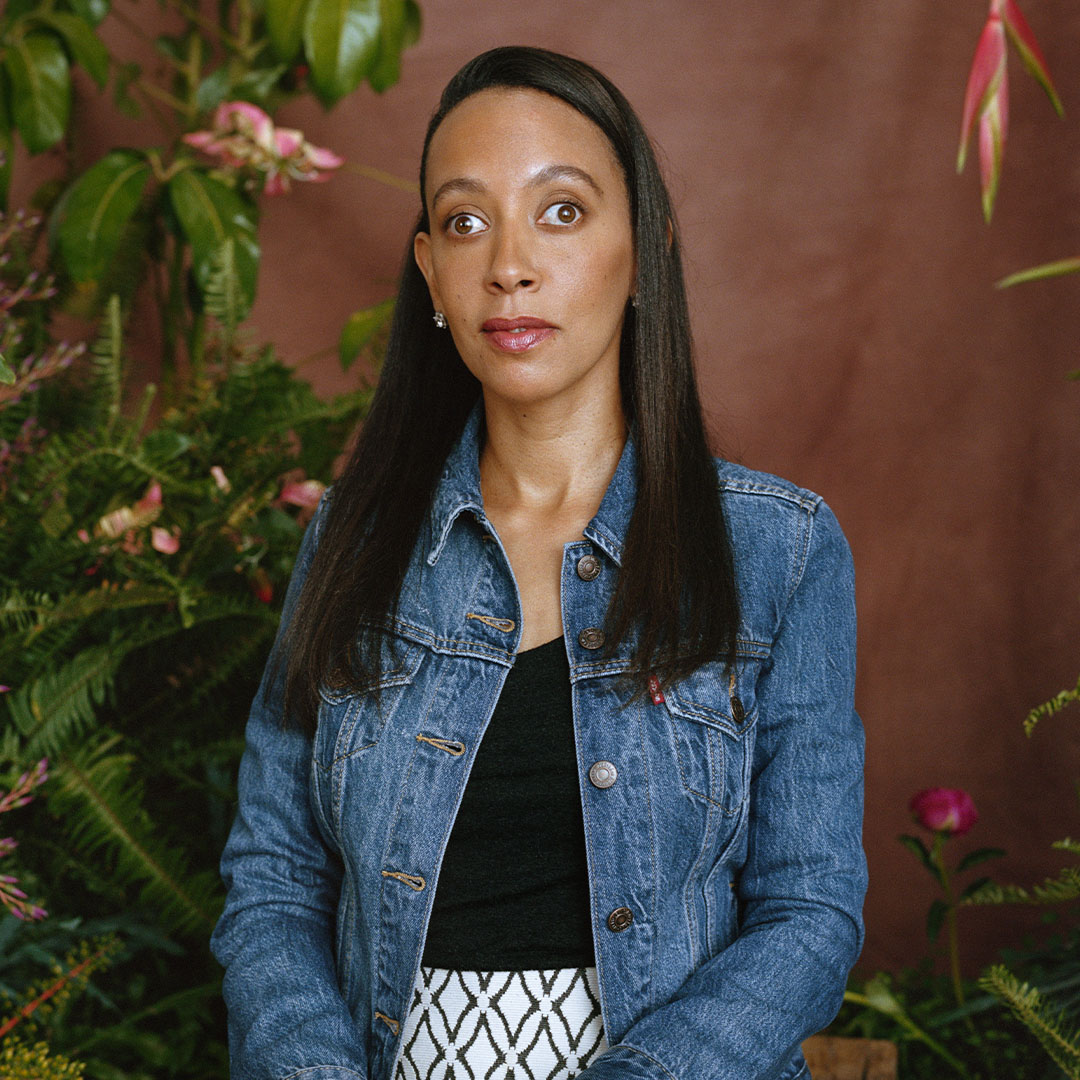




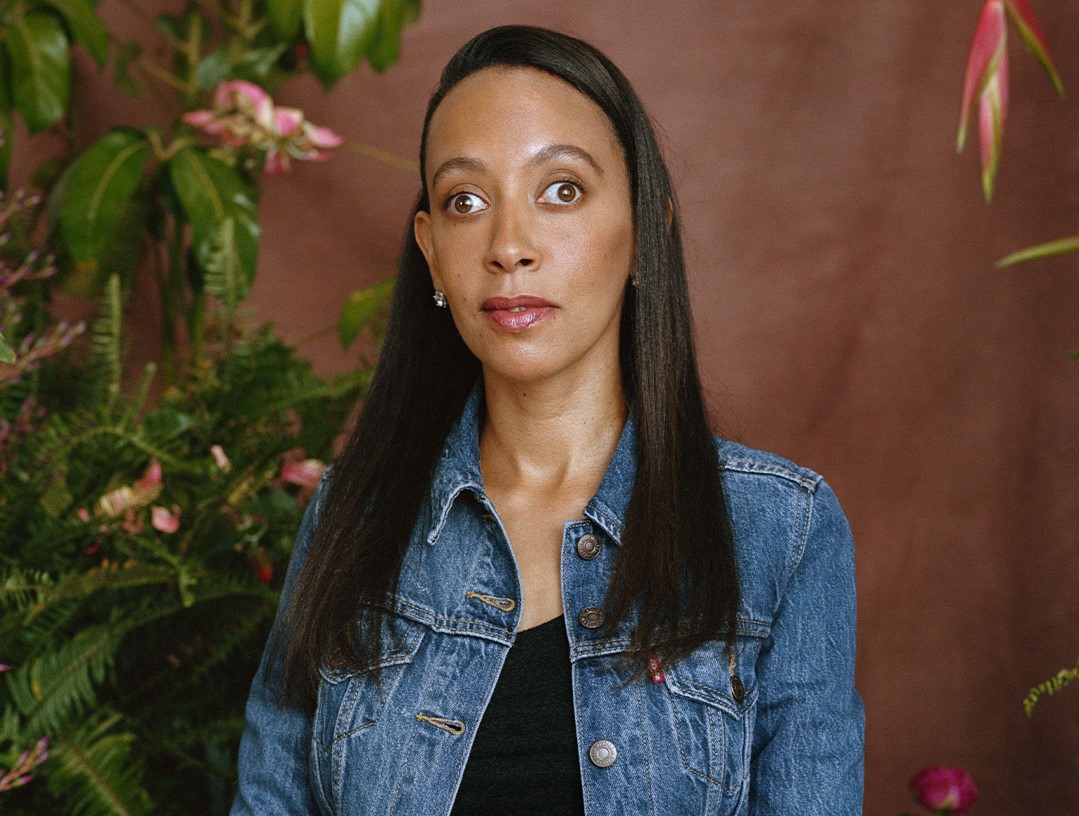












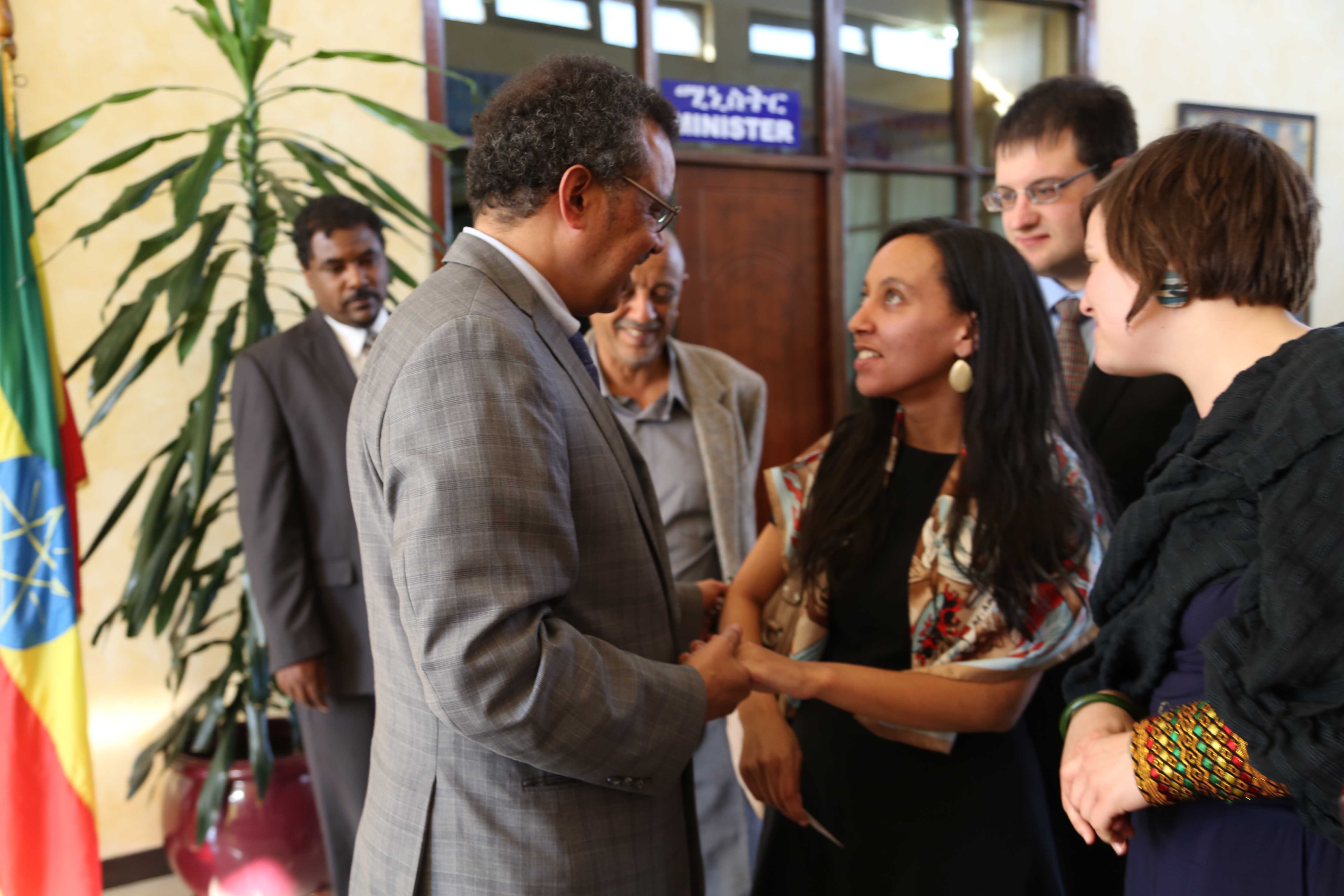
![Video: Haben Girma at Meet EBC with Tefera Gedamu on Ethiopian TV [Excerpt]](https://i.ytimg.com/vi/5RMFfQUAza0/maxresdefault.jpg)





